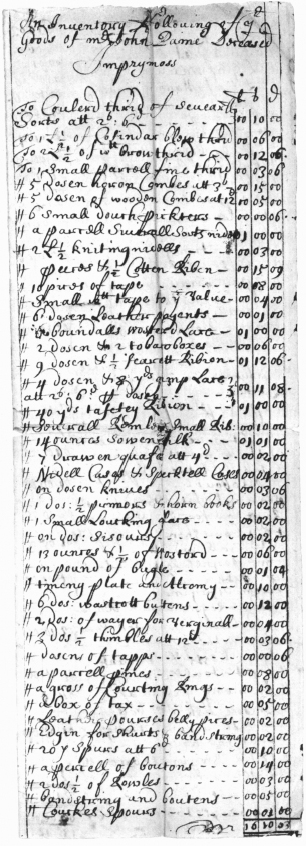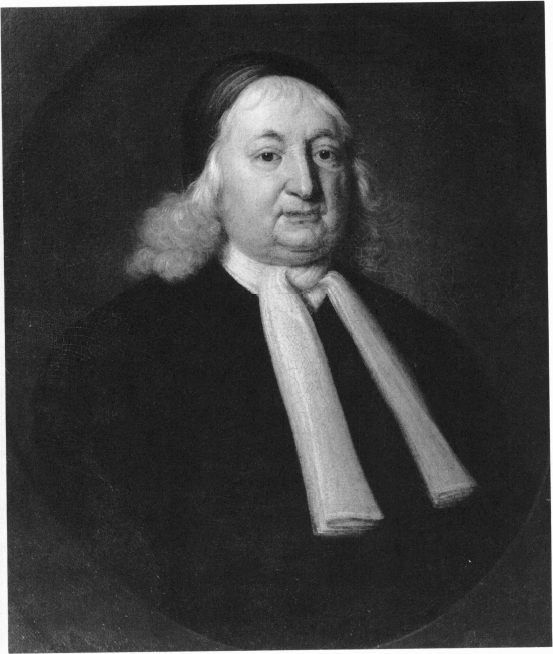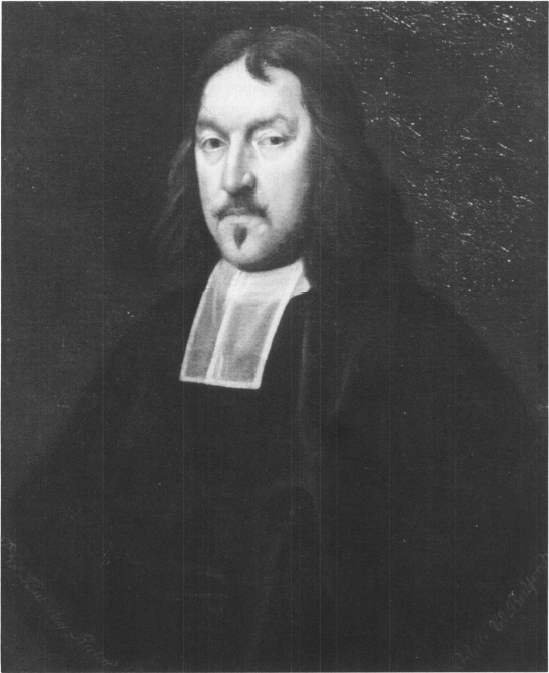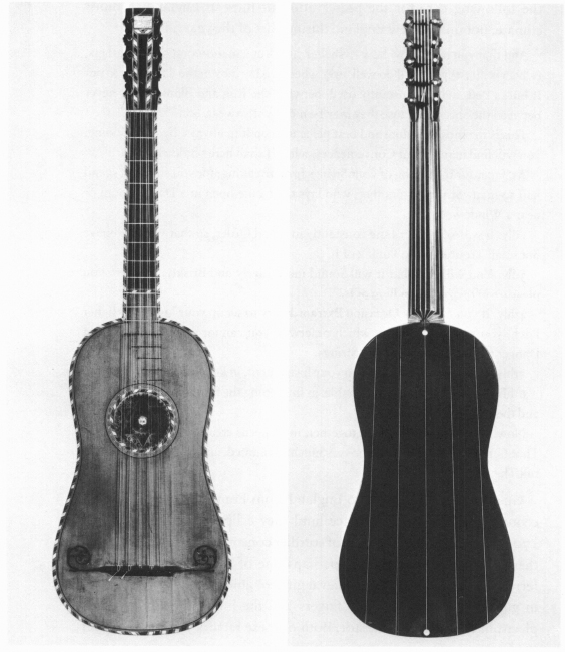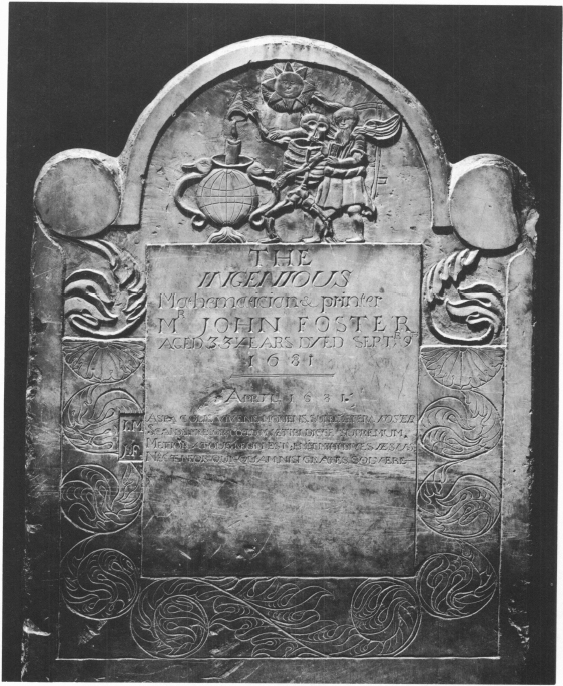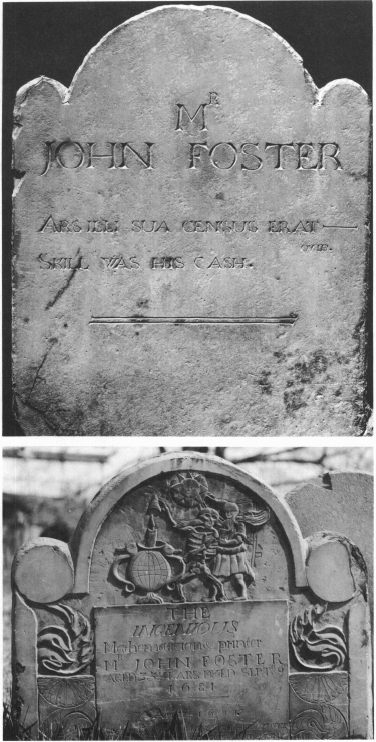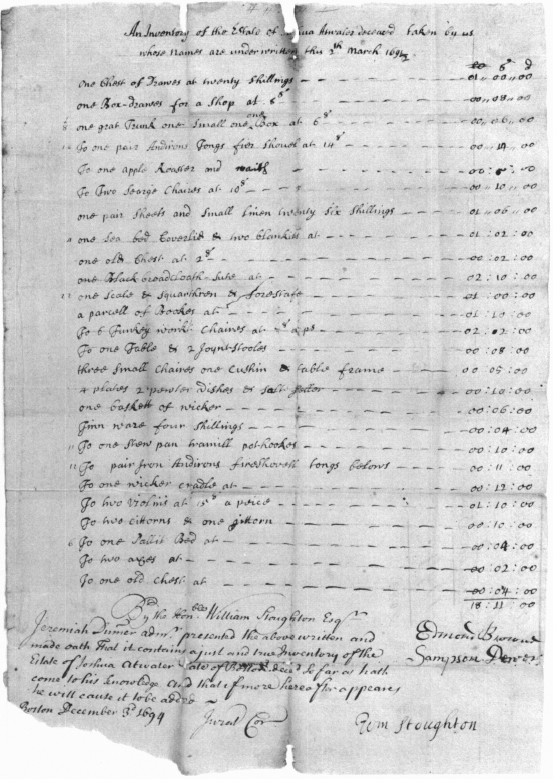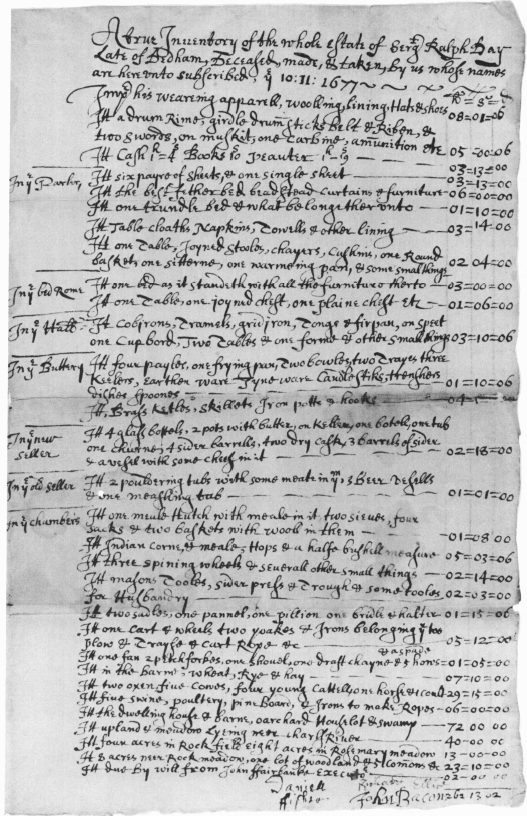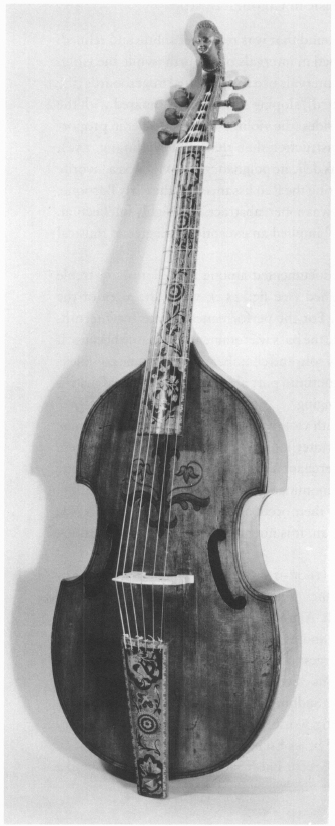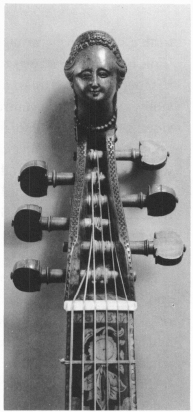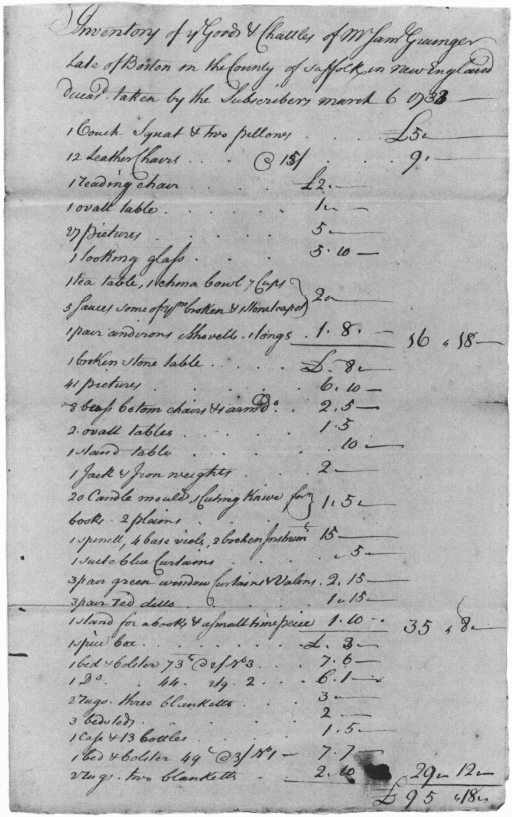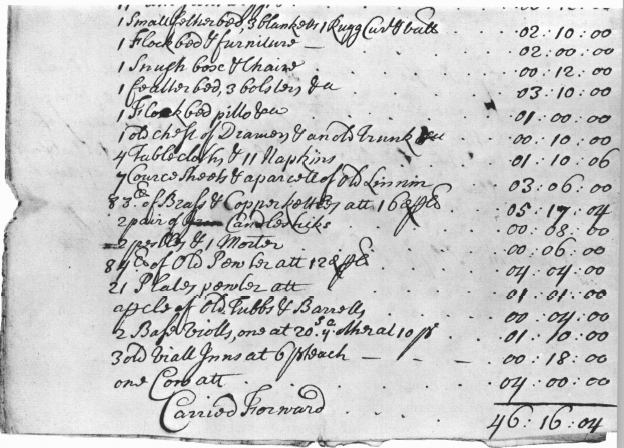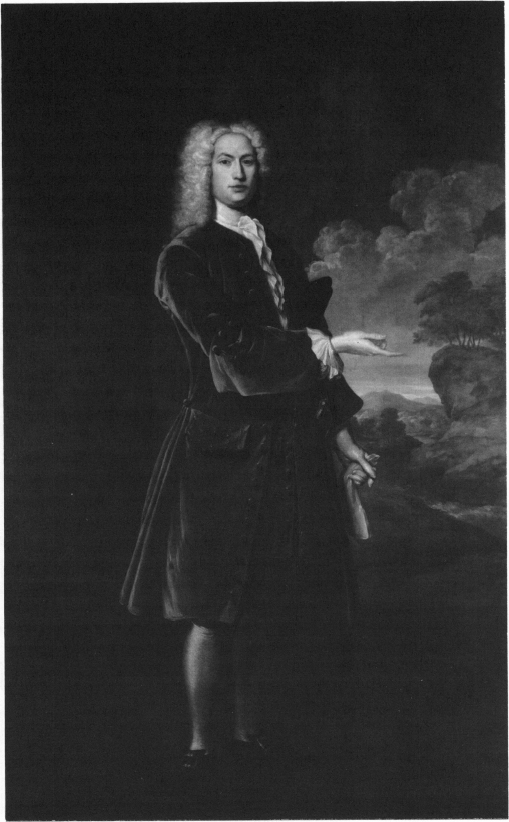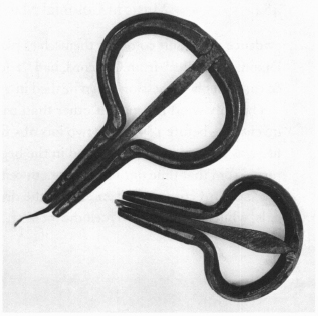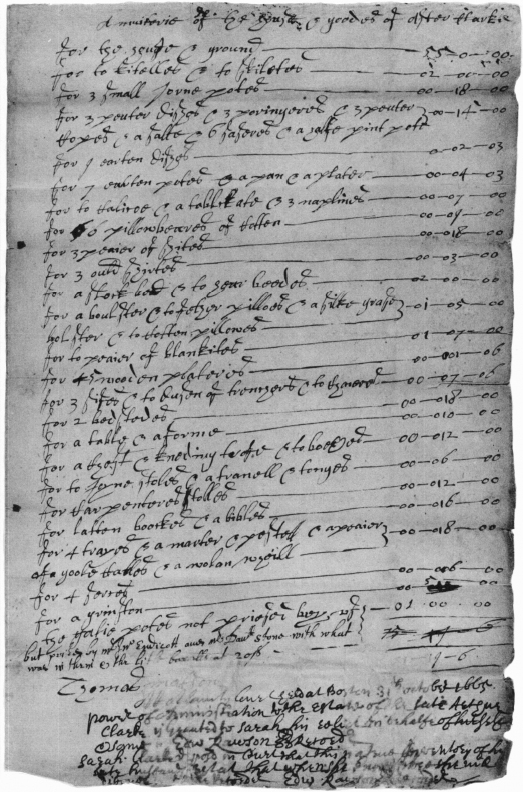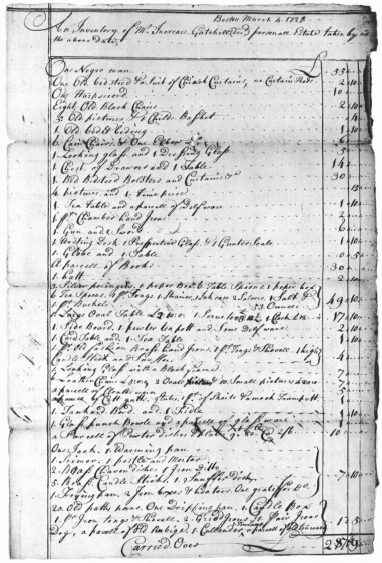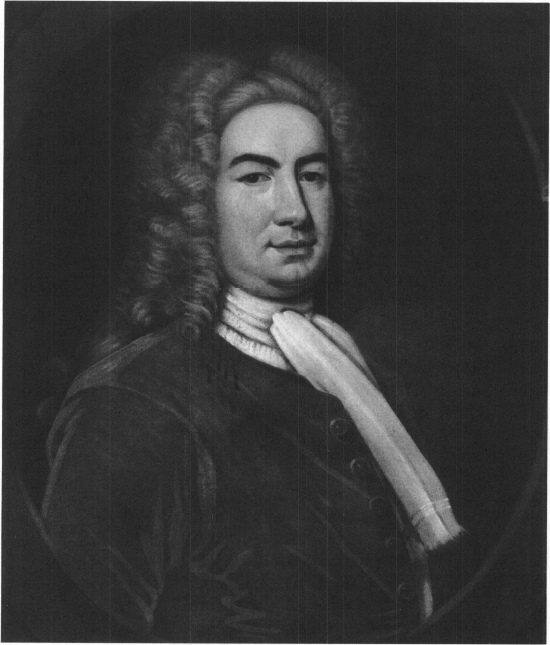Social Music, Musicians, and Their Musical Instruments in and Around Colonial Boston
Introduction
FOR the weeks of February 3 and 10, 1729, an advertisement appeared in the Boston Gazette (fig. 237). It announced the first public concert in the North American colonies.1 This study will seek to explore the secular social music practices in Boston and its environs prior to this first concert, that is, from the arrival of the first colonists in 1630 to approximately 1730.
Puritans settled the Massachusetts Bay Colony and dominated the area for several generations. It is well known that they simplified both the poetry and meter of the psalms,2 that they gradually changed from reading music to singing by rote, and that they prohibited the use of musical instruments during religious services. These and other facts led most nineteenth-century music historians and some from the present century to believe that the Puritans forbade secular social music and permitted only the recreational singing of psalms.3 In the light of new evidence, however, a group of twentieth-century scholars began to question this commonly held belief. Heading the movement which was to demonstrate that secular social music was in fact practiced in the Bay Colony were Percy Scholes and Henry Wilder Foote.4 In The Puritans and Music in England and New England Scholes established that there was a musical culture outside psalmody and that the Puritans participated in it. His argument was based largely on the musical practices of the English Puritans with some supporting evidence from New England. And Henry Wilder Foote in “Musical Life in Boston in the Eighteenth Century” asserted that Boston had an early thriving musical life, and used as evidence findings by Sonneck and Scholes as well as his own research into the sacred singing controversy.5
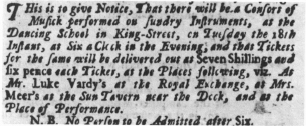
Fig. 237. Concert advertisement from the Boston Gazette, February 3, 1729.
Why this disagreement among respected music historians? Nineteenth-century music historians were very conscious of Puritanism as a powerful cultural force: a force which early passed a sumptuary law prohibiting decorative dress and elaborate finery for those of average and humble means;6 which dictated duties and virtues; which encouraged a constant contemplation of death and the belief that having been “born into this world of sin a sinner,” one must struggle mightily to avoid damnation; and which dictated that man must regulate his life and society according to God’s “Holy Ordinances.”
Scholes, Foote, and their followers, on the other hand, were particularly struck by the musical background of the immigrants. English music flourished in the late sixteenth and early seventeenth centuries when madrigals, keyboard music, lute songs, instrumental fancies, and consort music poured forth from such eminent composers as Byrd, Weelkes, Gibbons, Tomkins, Dowland, Coperario, Ravenscroft, Ward, Lawes, and Jenkins. This brilliant display achieved its culmination in the compositions of Henry Purcell in the late seventeenth century and Georg Frederic Handel in the century following.
In support of his thesis that the New England Puritans enjoyed secular social music, Scholes documented particularly well the strong musical background of the English Puritans. He showed that during the Puritan rule in England the publication of secular music was sizable and of high quality. He described Cromwell’s love of music and support of a musical staff during his administration. He reviewed the musical references of the Puritan poets Milton (whose father was a professional musician) and Marvell, and reminded the reader not only that the English Puritans did permit opera, but that it was initiated under Puritan rule.7 Scholes also recalled various examples of musical education during the English Commonwealth and explored the music profession in England. In short he demonstrated that only three musical activities were absent during the Puritan rule: (1) choir singing and the playing of musical instruments in church, (2) playing and singing in theaters, and (3) music in the court. Although the last was reinstated during the Restoration its practitioners suffered gravely because the court became some five years in arrears in payment of musicians’ salaries.8 Scholes’ research makes abundantly clear that many English Puritans approved of secular social music. Their only real objection was to elaborate church music which included the use of instruments. They felt it distracted the congregation from the religious content of the service and of the psalms.
In his quest for evidence that the New England Puritans practiced secular music, Scholes found few references to musical instruments. He culled a “treble viall, 10s” from the will of Nathaniell Rogers of Ipswich (d. 1655) and a reference to fiddling as well as dancing from a Salem Court case of 1679.9 From the diary of Samuel Sewall, the noted New England judge and journalist (1652–1730) who left so vivid a picture of life in the Massachusetts Bay Colony between 1674 and 1729, Scholes found reference to a virginal, a dulcimer, a fiddle, and several trumpets.10 Scholes continued to believe strongly, however, that the colonists, including the Puritans, practiced secular social music.
In short, when this study was begun, it was known that the New England Puritans had emigrated from a country rich in secular music; that their religious brethren in England continued to practice and sponsor secular social music, and that at least a few of the New Englanders had owned musical instruments. However, still lacking was definitive evidence of the existence of secular social music in New England prior to 1729.
If musical instruments were banned in religious observances, then proof of their existence would indicate the presence of a secular social music culture. If the Massachusetts Bay Colony had such a culture, then musical instruments should be found among the possessions of the colonists. An efficient way to document the existence of such instruments was to sift through the household inventories of the period.
Upon the death of the head of a household three court-appointed appraisers made an inventory of all objects in the house including movables, slaves and servants, livestock, as well as real estate. Only the clothing of surviving family members was excluded. Household items were usually listed in the order found, room by room.11 The household inventory was then taken to the clerk of courts who copied it into a large record book, assigned a single “docket” number to all of the original legal papers concerning the deceased. All were then filed in a single envelope bearing the docket number. By this means an individual’s estate was appraised and recorded for division among the heirs, either according to the will or, if he died intestate, according to a legal formula specified in the colonial laws of Massachusetts.12
The richest source of extant household inventories are the probate court records of the counties in the Massachusetts Bay Colony. As of the 1640s the colony contained four shires or counties: Suffolk, Middlesex, Essex, and Norfolk.13 Those in the first three shires or counties were selected for this study. All existing inventories in Suffolk and Middlesex filed between 1630 and approximately 1730 were scrutinized. Suffolk, containing Boston, was overwhelmingly urban; Middlesex was primarily rural. The published records from Essex County covering the years from 1635 to 1681 were also read.14
It was impossible for the writer to determine what proportion of the original records still exist from this 100-year period.15 Although Middlesex County was established as early as 1639, no inventories were recorded until 1648, and for the period under discussion no reliable population statistics are available. On the other hand, it is known that Boston, which included by far the greater part of the population of Suffolk County, by 1730 had attained 13,000 inhabitants. The Suffolk County Probate Records today contain approximately 6,500 dockets for the 100-year period under discussion which represent an estimated seven percent of the original records.16
Table i is a chronological list of the instrument references found by the writer. It includes the owner of each instrument, his dates, generation in the New World, place of residence, occupation(s), church affiliation, and the value of his estate. The value of each instrument and its location within the house are given whenever possible. The table was compiled from the household inventories examined in the probate court records of Suffolk and Middlesex Counties and from the published probate records of Essex County mentioned above. Table ii augments Table i with instruments associated with a particular individual and recorded in other primary sources, namely, town records, four Boston newspapers, and personal documents such as diaries, journals, and letters.17 Table iii cites occasions where instruments were played (dancing schools excluded). However, because the specific instruments, players, and/or owners are unidentified, instruments from Table iii are not included in the statistics. Table iii appears in order to document the use of instruments and to suggest the presence of additional instruments to those included in Tables i and ii.
The inventories themselves provide a record of at least 108 instruments.18 For the years 1630 to approximately 1730, 80 instruments were located in Suffolk County, 24 instruments were located in Middlesex County, 4 instruments were located in Essex County (for the period 1635 to 1681). Adding to these statistics the 50 instruments minimum from Table ii, the number recorded during this period totals 158 instruments at least. Of this figure, the variety and number of specific types of instruments19 reported can be summarized as follows: 28 plucked stringed instruments (2 lutes, 4 guitars or gitterns, and 22 citterns); 25 keyboard instruments (14 virginals, 5 harpsichords, 4 spinets, 1 organ, and probably 1 clavichord); 19 violas da gamba (3 trebles and 7 basses specified); 21 instruments of the violin family (19 violins, 1 tenor violin, and 1 “bass violine”); 26 drums; 16 trumpets; 5 horns (including 1 post horn, the other 4 probably were signal instruments and made of cow horn) at least 13 wind instruments other than buzzed-lip type (6 flutes, 5 fifes, a curtal, and a mock trumpet); 3 lots of jew’s harps (2 lots of which totaled 21); and a European-type dulcimer. For a people not reputed to practice instrumental music, the list is quite impressive.
A glance at Tables i and ii reveals that the greatest number of instruments was recorded between the years 1650 and 1700. In the 1650s there were 18 instruments along with one lot of 19 jew’s harps and the unspecified instrument in “Thomas Androus the scholar musician was there with his music.”20 In the 1660s there were 21 instruments, an entry for “2 dos: of wayer for Verginall” found among the items in a cloth merchant’s shop (fig. 238), and “a pcell. Citternwier” in the shop of an ironmonger who might possibly have been drawing the wire himself.21 In the 1670s there were 17 musical instruments and the Rev. Edmund Browne’s “base voyall, with all my musicall bookes & instrumts.” In the 1680s there were 15. In the 1690s there were 19 recorded along with an unspecified number of jew’s harps. And from 1700 to 1709 there were 7 and the books which went with Joseph Curtis’ virginals. In the 1710s 9 instruments appear among the documents. In the 1720s there were at least 29 in addition to an entry for “a pcell. of Catgutts, fflutes. . . .”22 The statistics from these documents suggest that if there was a period in which there was a decline in the number of musical instruments in the Massachusetts Bay Colony it was a rather brief one.
Fig. 238. Page from the household inventory of John Paine, Boston, 1665.
A general assessment of the owners of musical instruments in Tables i and ii should be made before proceeding with a more detailed account of their lives and instruments. From the tables can be obtained at least partial answers to the following questions. Were the owners rural or urban dwellers? Were they first-generation settlers or their descendants? Were they Puritans (Congregationalists), Anglican, or what? And what were their occupations and wealth?
Seventy-two instrument owners were identified in the probate records of Suffolk, Middlesex, and Essex Counties. This list was augmented (see Table ii) by 48 more instrument owners documented in other primary sources. Of the total number of 71 individuals found among the probate records, 36, or a little more than half, were Boston residents. When the owners identified by the other primary sources are added, the total number of possessors of musical instruments living in Boston climbs to 64, or again a little more than half.
Throughout the period under discussion the ratio of first- to later-generation owners is one to one: 38 were first-generation colonists who migrated to the New World as adults, 37 were later, who were either born or grew up in the New World, while the generations of 44 are unknown. Since the incidence of instrument owners neither increased nor decreased appreciably during later generations, one can assume the continuance of a musical tradition.
Puritans dominated the Massachusetts Bay Colony until 168423 when the early liberties granted them by the Crown were rescinded, and the Bay Colony became a royal province with royally appointed officers. Until 1679 Puritans denied Baptists the right to worship in the colony and persecuted those who disobeyed. In 1686 the first Church of England minister arrived, but it was not until 1689 that King’s Chapel was established by the Anglicans.24
Of the 72 individuals identified in the probate records as possessing musical instruments between 1630 and approximately 1730, 41 were Puritans, 27 were of unspecified religious affiliation, while only 3 were Anglicans.25 These figures clearly refute a recent assertion. In 1951 Cyclone Covey flatly stated that secular music in Boston was practiced exclusively by the Anglicans and not by the Puritans:
Secular music did not flourish among the puritans. Not a single musician of any note, whose religion can be verified, in either England or America during the entire colonial period—composer, performer, or music printer—was a puritan. Every single musician adduced to prove that the puritans remained musical during the Commonwealth and Protectorate was an Anglican.26
Although weakly challenged by Clifford K. Shipton,27 Covey’s premise was supported by Walter Muir Whitehill. Whitehill in his characteristically thoughtful and searching manner read through four volumes of Sibley’s Harvard Graduates and found that “of the forty-odd references to music in Mr. Shipton’s volumes, thirty refer to some phase of the [singing] controversy.”28 Because the references were almost entirely concerned with religious singing, Whitehill concurred with Covey. What Whitehill neglected to consider was that the major thrust of a Harvard education during the colonial period was toward the ministry. A biographical sketch naturally covers in greatest depth the factors surrounding an individual’s occupation or principal means of livelihood and identification. The singing controversy erupted in the 1720s and pitted those in the congregations who wished to “sing by note” against those who advocated the old way of singing “by rote.” It was a major focus of contention for a large portion of the ministers and remained alive well into the 1780s. It therefore seems only natural that so vital a concern for so many Harvard graduates would be mentioned often, while their possession of musical instruments and their practice of secular social music for recreational purposes might go unrecorded in the limited space given to each sketch. In any case, the findings in the present study should discourage anyone who still believes that Puritans practiced no instrumental music.
A wide spectrum of colonial occupations and wealth are represented by the owners of musical instruments. The merchant class was the largest. Of the 15 merchants who possessed instruments, 2 specialized in cloth while 7 others reportedly had a second occupation: sea captain, large landowner, treasurer of the Massachusetts Bay Colony, mariner, ironmonger, innkeeper, and cooper. In addition there were 4 shopkeepers (one of whom also specialized in yard goods), 1 tailor, 2 ironmongers (one of whom, as noted above, was also a merchant), 7 mariners (including the merchant and the shopkeeper, aforementioned), and 6 innkeepers (one doubling as a cloth merchant, cited above). There were at least 11 yeomen (one serving occasionally as a minister), 7 full-time Puritan ministers, 3 schoolmasters (one became a printer), 2 governors, 2 lawyers (one was also an advocate general), 2 surgeons, 1 physician, and 1 barber, 2 brickburners, 2 coopers (one also specialized in wine), a shipwright, a trader, a smith and a soapboiler, a weaver, a joiner, a woodworker.
The owners’ estates ranged in value from £14 to £4,540. Only 7 were appraised at over £1,000; 32 fell between £1,000 and £200; 26 were under £200; and the values of 3 are unknown.29 In summary, the possessors of musical instruments seemed to be of the middle class, but within the wide range of occupations identified.30 The old idea that a taste and talent for social music making could not have existed in the colonies except among a small and exclusive group strongly attached to the Old World begins to fade in the light of the new evidence.
Musical Instruments and Their Owners from the Inventories of Suffolk, Middlesex, and Essex Counties
sources: M Probate Records, Middlesex County Courthouse, Third District, Cambridge. PREC Probate Records of Essex County, 1635–1681, 3 vols. (Salem: Essex Institute, 1916–1920). S Probate Records, Suffolk County Courthouse, Boston.
| Owner | Gen. | Church | Value of estate (li.s.d.) | Instruments | Location in home |
|---|---|---|---|---|---|
|
John Simson (1605–1645) Watertown; yeoman S, ii, 43; docket 34 fig. 240 |
1st |
74.–5.–4 |
“A owld payre of virginalls an owlde trunke & hydes & [7] coushins at 8–s———01„15„ [cropped]” |
||
|
John Winthrop (d. 1649) Boston; governor S, i, 488; docket 79 |
1st |
First |
103.10.11 |
“drumme heades 00–10–00” |
in parlor |
|
James Astod (d. 1653) Boston; merchant, Ar. Co. 173931 S. ii, 148; docket 134 |
1st |
Second |
928.18.–3 |
“A payer of smale virginalls att 40s 002·00·00 [total]” |
“In the Paller” |
|
Capt. William Tyng (d. 1653) Boston; merchant, treasurer of Massachusetts Bay Ar. Co. 163932 S, ii, 138; docket 128 |
1st |
First |
2,774.14.–4 |
“1 Drum with drumsticks & a case 2·00·00” “7 vialls 3 Congregational Churches Singing Psalmes” |
“in Hall” [with books] |
|
Augustine Walker (d. 1654) Charlestown; sea captain and merchant M, i, 162; docket 23533 |
1st |
Charlestown |
221.–7.–6 |
“1. Citterne 5/s” |
“In Garrett” |
|
Daniel Rolfe (d. 1654) Ipswich PREC, i, 176; E 11, leaf 134 |
?1st |
74.17.–8 |
“a drum & sticks, 2li” |
||
|
Edward Gibbons (d. 1654) Charlestown; merchant, landowner S, ii, 189–194; misc. docket |
1st |
First |
830.–6.–1 |
“1 par of old Virginalls” “1 Whistle & chayne of silver” |
“In ye new Hall chamber” “In the study” |
|
Nathaniell Rogers (d. 1655) Ipswich, minister PREC, i, 222–225; docket 24,042 |
1st |
Church of Christ |
1,497.12.–4 |
“a treble violl 10s” |
“In the Parlour” |
|
Capt. Robert Keayne (1595–1656) Boston; tailor, merchant, Ar. Co. founder, representative S, iii, 165–173; docket 171 |
1st |
First |
2,427.12.–1 |
“A Drume and another great Sadle bridle and stirrups 3.–.–” |
“In another little Roome in ye Garret” |
|
Samuel Andrew (d. 1659) Middlesex County; shopkeeper M, i, 252; docket 266 |
?1st |
487.14.–8 |
“1 doz. 7. Jues harpes—.–1.–7” |
||
|
Peter Bulkeley (1583–1659) Concord; minister M, i, 199; docket 3420 |
1st |
Concord |
1,302.—.11 |
“2 lutes 4/00/00” |
“In the new chamb.” |
|
Comfort Starr (1589–1660) Boston; surgeon S, iii, 314–315; docket 223 |
1st |
First |
404.13.— |
“A Smale Carpitt & a Gittorne 00.06.00” |
|
|
Joseph Farnworth (d. 1660) Dorchester; yeoman S, iii, 298–300; docket 232 |
1st |
Dorchester |
206.28.–2 |
“A trible viall and a Cithern 1.00.00” |
“i ye Celler” |
|
John Pierce (d. 1661) Watertown; weaver M, ii, 2; docket 17493 |
1st |
263.–2.— |
“2 chayres, 3 cushins, 1 Treble viole, 1 looking glass—16–06” |
“In the new chamber” |
|
|
Boston; joiner S, iv, 60–61; docket 284 |
1st |
First |
249.—.–3 |
“1 drume 1.00.00” |
“In the Garrett” |
|
Nathaniel Upham (d. 1662) Maiden/Cambridge; ?yeoman, sometime preacher M, ii, 34–37; docket 23206 |
1st |
Malden |
48.17.— |
“By a Cittorne & a Case for it—15—” |
“His Linnen” |
|
Moses Bordman (d. 1662) Cambridge; Pyeoman M, ii, 86–95; docket 2228 |
2nd |
?Cambridge |
74.14.–6 |
“A drum with its Appurtenances 1·15—” |
|
|
Samuel Haugh (1621–1662) Reading; minister M, iii, 32; docket 10756 |
2nd |
Reading |
1,797.11.10 |
“1 Citturne 000.08.00” |
“In the Parlour” |
|
Henry Blague (d. 1662) “Braintrey” /Boston; “brickburnor” S, iv, 105; docket 310 |
1st |
First |
464.12.–9 |
“A Cittorne & a hat rufe 00.08.00” |
|
|
Andrew Cloade (d. 1664) Boston; wine cooper S, iv, 203–204; docket 365 |
?1st |
417.15.— |
“Drumme & Drummesticks 2.10.00” |
“In the Backe Chamber” |
|
|
Robert Cutler (d. 1665) Charlestown; ironmonger yeoman and deacon M, ii, 217; docket 231 |
1st |
Charlestown |
602.–8.–2 |
“A pcell. Citternwier & brass pullyes 2/10/—” |
“In the new shop” |
|
Arthur Clarke (d. 1665) Boston; ?woodworker S, iv, 251; docket 388 fig. 261 |
1st |
First |
71.19.–6 |
“3 fifes & to duzen of trenchers & to Chaieres 00.07.06” |
|
|
Boston; shopkeeper S, iv, 251–253; docket 390 fig. 238 |
135.12.— |
“2 dos: of wayer for verginall 00/4/00” |
[in shop] |
||
|
Peter Hubbard (d. 1665) Hingham; mariner S, iv, 267; docket 393 |
First |
197.–8.–– |
“1 citterne & Silver 2.05.00” |
||
|
Benjamin Richards (d. 1666) Boston, merchant S, va, 40–41; docket 435 |
2nd |
81.–2.— |
“1 pr virginalls 2.—.—” |
“In the parlor” |
|
|
Thomas Wells (d. 1666) Ipswich; yeoman PREC, ii, 72; docket 29,314 |
1,214.–3.–3 |
“a citterne, 10s. 1” |
|||
|
Samuel Winsley (d. 1667) Salisbury PREC, ii, 83; docket 30,177 |
421—1.— |
“a sittern, 1li” |
|||
|
Jonathan Browne (d. 1667) Salem; ?merchant PREC, ii, 84; E v, leaf 2 |
68.–8.–8 |
“one old sitterne & an old case with some bottells & an old barrell, 6s8d” |
|||
|
Jonathan Eliot, Jr. (1636–1668) New Cambridge (Newton); minister, H.C.165633 M, iii, 202–211; docket 144 |
2nd |
First; to New Cambridge (Newton) |
457–2.–5 |
“1 citterne & a Case 000.08.00” |
“In the Study” |
|
William Whittingham (ca. 1640–1672) Boston; merchant, H.C. 166034 S, vii, 224–230; docket 602 fig. 243 |
2nd |
686.–5.10 |
“1 p. of Virginalls w/ a fframe 2„—„—” |
“In the Kitchin Chambr.” |
|
|
Lieut. Joshua Fisher (d. 1672) Dedham; yeoman S, vii, 239; docket 607 |
2nd |
Old South |
1,145.–6.–5 |
“. . . one Citterene 5s” |
“In the parlour” |
|
Richard Gridley (d. 1674) Boston; brickmaker and capt. of Ar. Co. S, va, 213; docket 712 |
1st |
Old South |
92.16.— |
“by his arms he traynd with & 2 fifes & 2 Chests & still 3 cases w/ 3 or 4 botells in them & a small—2„05„00” |
|
|
Nathan Raynsford (1641–1676) Boston; cooper and merchant S, va, 322–331; docket 762 |
2nd |
First |
2,233.–5.–3 |
“1 pr of virginals & fframe—„10„00” |
“In ye Chamber over ye hall” |
|
John Franks (d. 1676) Boston; cloth merchant and innkeeper S, xii, 184–185; docket 836 |
First |
187.–3.–8 |
“One Cittron 15s” |
||
|
Ralph Day (d. 1677) Dedham; yeoman S, xii, 200–201; docket 933 fig. 250 |
1st |
Dedham |
262.13.–2 |
“1tt one Table, Joyned Stooles, chayers, Cushins, one Round basket, one sitterne, one warmeing pan, & some smal things 02 04–00” |
“In ye Parler” |
|
Samuel Alcott (1637—1677) Roxbury; physician, H.C. 165935 S, xii, 144–145; docket 882 |
2nd |
Roxbury (deacon) |
639.15.— |
“1 Great Looking glas–1 Cittron & case napkins, cloth goods 2„—„—” |
“In the Parlor” |
|
Thomas Shepard (1635–1677) Charlestown; minister, H.C. 165336 M, v, 470; docket 408 |
2nd |
Third; Charlestown |
2,386.–4.— |
“A Citharen 000 10 00” |
|
|
Rev. Edmund Browne (1606–1678) Sudbury; minister M, v, 83–91; 2984 fig. 253 |
1st |
Sudbury |
713.12.–3 |
“base voyall, with all my musicall bookes & instrumts” |
“in my Study” |
|
Boston; mariner S, xii, 348; docket 1134 |
85.–8.— |
“1 old Cittern—„02„—” |
“In the Hall” |
||
|
Hopestill Foster (d. 1679) Dorchester; smith and soapboiler, Ar. Co. 167437 M, v, 267; docket 8199 |
2nd |
Second |
47.–2.–6 |
“drum 1·10·0” |
|
|
Elizabeth Holloway (d. 1680) Boston; cloth shopkeeper S, ix, 4–6; misc. docket |
1st |
First |
458.–8.— |
“one cittern 12s” |
|
|
John Foster (1648–1681) Dorchester/Boston; schoolmaster and printer, H.C. 166738 S, ix, 105; docket 1193 |
2nd |
Dorchester |
106.–3.–6 |
“Guittawur, viall, weather glasses 1„5„—” |
|
|
David Jackson (d. 1683) Boston; tailor S, ix, 152; misc. docket |
14.14.–3 |
“One old Cittern 4s” |
|||
|
Capt. William Condey (d. 1685) Boston; mariner S, ix, 271; docket 1435 |
?1st |
Second |
201.16.— |
“a Quilt, a Cytorn, a baskett & Toyes 3„0„0” |
“In the Chamber” |
|
Capt. John Frost (1633–1687) Boston; mariner S, x, 52–55; docket 1530 |
2nd |
408.15.— |
“One paire of Small Virginalls—„15„—” |
“In the North Chamber” |
|
|
William Marshall (d. 1688) Charlestown; mariner M, vii, 74; docket 14729 |
Charlestown |
230.18.10 |
“1 Cittorn, Andirons, doggs, fireshovell. Tongs Looking glass, glasses 2:12:00” |
“In ye Chamber” |
|
|
Boston; “chyrurgeon” representative 1689, 1690 S, viii, 192–193; docket 1816 |
3rd |
[freeman] |
258.16.10 |
“1 Jack, 1 old Guittar—„16„—” |
“In ye Hall” |
|
John Clarke (d. 1691) Boston; mariner and merchant S, viii, 211; docket 1870 |
Second |
27.19.— |
“1 pr Virginals old—5—” |
||
|
Joshua Atwater (1658–1692) Boston; mariner and shopkeeper Ar. Co. 167739 S, xiii, 508; docket 2083 fig. 248 |
2nd |
First |
18.11.— |
“two violins at 15s a peice 1:10:00” “two cittorns & one gittorn 00:10:00” |
|
|
William Greenough (1641–1693) Boston; shipwright, Ar. Co. 167540 S, xiii, 238–239; docket 2066 |
1st |
Second |
1,245.–9.–4 |
“A Glas and chaires and a pair of Virgenals 13.14.—” |
|
|
Jonathan Cleasby (1633–1695) Charlestown; shopkeeper M, viii, 788–789; docket 4607 |
1st |
13 6.–3.— |
“Jews harps 6s” |
||
|
John Dyer (1643–1696) Boston; ironmonger, Ar. Co. 169141 S, xi, 192; docket 2244 |
2nd |
First |
854.11.11 |
“2 flutes 2s” |
|
|
William Bryant (d. 1697) Boston; taverner S, viii, 85; docket 2409 |
192.16.—8 |
“a Violin with Case & 2 pictures 20/all” |
“In the little Chamber” |
||
|
Rev. Charles Morton (ca. 1627–1698) Charlestown; minister M, x, 361–362; docket 15593 fig. 256 |
1st |
Charlestown |
95.14.–4 |
“2 Base Vialls, one at 20s ye other at 10 pe 01:10:00 3 old Viall Inns at 6 pe Each 00:18:00” |
|
|
Joseph Curtis (d. 1700) Sudbury; yeoman M, x, 224; docket 5473 |
992.14.— |
“his Virginalls & Books belonging to it” |
|||
|
Jacob Amsden (1657–1701) Cambridge; glazier M, x, 454–455; docket 409 |
2nd |
[salaried as glazier to Cambridge meetinghouse] |
171.–8.–4 |
[trumpet; see Table ii] |
|
|
Samuel Kendall (d. 1711) Boston; innkeeper S, xvii, 291–292; docket 3293 fig. 402 |
1st |
949.10.–9 |
“1 Table 2 Carpets 2 looking glasses 1 brush One fidle 5 pair of Shoes 1 Muff 4„14„—” |
||
|
James Kettle (1665–1712) Charlestown; barber M, xiii, 206; docket 13163 |
2nd |
Danvers |
309.–4.–6 |
“a drum, a saddell & pillian & a small parcell of flaggs 2/13/0” |
|
|
Thomas Brattle (1658–1713) Boston; merchant, H.C. 167642 S [will only], xviii, 103; docket 3467 |
2nd |
Old South and Brattle Square |
chamber organ |
||
|
Capt. Walter Rosewell (d. 1717) Chatham Co., Kent; mariner S, xx, 88–90; docket 3842 |
665.10.–5 |
“1 Flute & book „6„—” |
|||
|
Nathaniel Dunton (1656–1718) Needham; yeoman S, xxi, 67–68; docket 4062 |
2nd |
54.–8.–9 |
“half a pound of Whalebone & an ould Trumpit „4„—” |
||
|
Boston; innkeeper S, xxi, 602; docket 4248 |
170.—.–7 |
“1 pr Virginals 20/—” |
|||
|
James Scolley (1671–1721) Boston; shopkeeper S, xxii, 262; docket 4449 |
2nd |
180.–9.–6 |
“3 canes 1 fflut 1 Glass Lanthorn 2„—„—” |
||
|
John Valentine (d. 1724) Boston; advocate general S, xxiii, 245–246; docket 4850 |
2nd |
King’s Chapel |
4,169.–9.–7 |
“. . . 1 pr Virginals 5li” |
“In the Meale Chamber” |
|
John Carey (1699–1724) Boston; innholder S, xxiii, 507; docket 4988 |
2nd |
670.13.–6 |
“One pair of Virginals 2„—„—” |
||
|
Robert Dixon (d. 1724) Concord; trader M, xvii, 175; docket 6268 |
61.11.–9 |
“. . . 1 old Violoan & case 3 Copper farthings 10/3 9 pr Shubuckels & 2 Jews harps—„2„6” |
|||
|
Joseph Heald (d. 1724) Stow; yeoman M, xvii, 102; docket 11065 |
633.–2.— |
“a drum £2” |
|||
|
Increase Gatchell (d. 1729) Boston; schoolmaster, Ar. Co. 172743 S, xxvii, 277–278; docket 5729 fig. 263 |
Christ’s |
307.—.— |
“One Harpsicord 10„—„—; . . . a parcell of Catt gutts, flutes 1 pr of Skaits & a mock Trumpett 1„—„—; 1 Tankard. Bord. and. 1 Fidle 1„10„—” |
||
|
Gov. William Burnet (1688–1729) Boston; gov. of Mass. 1728–1729 S, xxvii, 337–348; docket 5849 figs. 270, 372 |
1st |
King’s Chapel |
4,450.–4.–3 |
“Andrew a Negro Man a Trumpeter 100„—„—. . . A Large bass violine 5li Two Trible Violins 30/7 8„00„0 A Harpsicord 60„—„— A Clepsicord 15„—„— A double Courtell 2„—„— A large Violin or Tenor fidle 2„—„—. . . Two Brass Trumpets £04„—„—” |
|
|
Jonathan Bancroft (d. 1733) Reading; yeoman M, xx, 127, xix, 295; docket 967 |
2nd |
935.10.–3 |
“to a Trumpett 5li” |
||
|
John Reed (d. 1733) Woburn M, xix, 406; docket 18530 |
117.17.–8 |
“a drum 20/s” |
|||
|
Samuel Grainger (1686–1734) Boston; schoolteacher S, xxx, 500–501; docket 6544 fig. 254 |
King’s Chapel |
507.10.–4 |
“1 spinett, 4 base viols, 2 broken Instrumts 15———” |
Musical Instruments Found in Sources Other Than Household Inventories
sources:
ArCo Oliver Ayer Roberts, History of the Military Company of the Massachusetts Now Called the Ancient and Honorable Artillery Company of Massachusetts (Boston, 1895).
BEP Boston Evening-Post.
BG Boston Gazette.
BLD The Diaries of Benjamin Lynde and of Benjamin Lynde, Jr., ed. F. E. Oliver (Boston, 1880).
BNL Boston News-Letter.
BRC Reports of the Record Commissioners of the City of Boston, 39 vols. (Boston, 1876–1909).
DSGP D. S. Greenough Papers, Massachusetts Historical Society.
ECF Alice M. Earle, Customs and Fashions in Old New-England (N.Y., 1893).
IMD Increase Mather’s Diary; published in Massachusetts Historical Society, Proceedings, 2nd Ser., xiii (1899–1900).
JMD John Marshall’s diary; published in Massachusetts Historical Society, Proceedings, 2nd Ser., xiv (1884–1885).
LHD Capt. Lawrence Hammond’s journal; published in Massachusetts Historical Society, Proceedings, 2nd Ser., vii (1891–1892).
MuBA Eileen Southern, Music of Black Americans (New York, 1971).
NEC New-England Courant.
NEWJ New-England Weekly Journal.
PTJ Peter Thacher’s ms journals, Massachusetts Historical Society.
RFQCEC Records and Files of the Quarterly Courts of Essex County, Massachusetts, 8 vols. (Salem: Essex Institute, 1912–1921).
RSCC Suffolk County Court Records; published in Colonial Society of Massachusetts, Collections, xxix (1933).
SHG Sibley’s Harvard Graduates.
SKJ The Journal of Madam Knight, intro. Malcolm Freiberg (Boston, 1972).
SSD The Diary of Samuel Sewall, 1674–1729, ed. M. Halsey Thomas, 2 vols. (New York, 1973).
The Use of Musical Instruments
| Date | Use | Occasion | Location | Source |
|---|---|---|---|---|
|
1653 June 25 |
ensemble |
Pupils of Michael Wigglesworth with “ill cōpany playing musick” |
Cambridge: Harvard College |
SHG, i, 264 |
|
1657 |
ensemble |
“Thomas Androus the scholar musician was there with his music” |
Ipswich |
RFQCEC, vii, 80 |
|
1678 |
disturbance: ensemble and dancing |
“at Mr. Crod’s house” reported by Josiah Bridges |
Essex County |
RFQCEC, vii, 80 |
|
1686 Oct. 14 |
parade with viols and drums |
Celebration of king’s birthday |
Boston |
SSD, i, 123–124 |
|
1687 May 1 |
Maypole |
public dancing |
Charlestown |
IMD, 411 |
|
1688 Sept. 28 |
ensemble |
On board Duke of Albemarle’s yacht |
Boston Harbor |
SSD, i, 178 |
|
1697 Jan. 1 “break of day” |
levit |
played outside Sewall’s house beneath his bed chamber |
Boston |
SSD, i, 367 |
|
1713 |
ball |
Gov. Dudley’s ball |
Boston |
ECF, 241 |
|
1716 May 23 |
ensemble |
City council dinner: “Had no Musick, Though the Lieut Govr [William Tailer] had promised it.” |
Boston |
SSD, ii, 820 |
|
1716 Nov. 29 |
ball |
Edward Enstone’s ball |
Boston |
SSD, ii, 838 |
|
ball |
Gov. Samuel Shute’s ball |
Boston |
SSD, ii, 878 |
|
|
1721 Dec. 22 morning |
levit |
to celebrate wedding of . . . “Two Africans . . . One . . . is said to belong to a certain famous Lawyer of this Town” |
Boston: outside newlyweds’ house |
NEC, Dec. 18, 1721 |
|
1724 Aug. 26, 28 |
2 frolicks |
attended by Benjamin Lynde, Jr. |
?[near Salem] |
BLD, 133 |
|
1727 Apr. 15 |
serenade |
in the night “three musicians serenaded me under my Chamber Window” |
Boston: Sewall’s house |
SSD, ii, 1052 |
|
1727 Oct. 19 |
dance |
Dancing School |
NEWJ, Oct. 16, 1727 |
|
|
1729 Feb. 18 Six a Clock |
“Consort of Musick on sundry Instruments” |
public concert |
Boston: “Dancing School in King-Street” |
BG, Feb. 3, 10, 1729 fig. 237 |
|
1730 Jul. 14 |
dance |
after Inferior Court session |
? [?Salem]: at surveyor’s house |
BLD, 135 |
|
1730 Nov. 24 [n.t.] |
“Consort of Musick . . .” |
Men’s Musical Society: Anniversary Feast in honor of St. Cæcilia |
Boston: Stephen Deblois’ house |
BG, Nov. 23, 1730 |
|
1731 Dec. 30 Six a Clock |
“Concert of Musick on sundry Instruments” |
public concert |
Boston: Pelham’s great Room in House of late Dr. Noyes near the Sun Tavern |
BG, Dec. 20, 1731 BNL, Dec. 16, 23, 1731 fig. 426 |
|
dance |
Benjamin Lynde, Jr.’s dance |
Salem: Lynde house |
BLD, 135 |
|
|
1732 Mar. 20 |
dance |
William Browne’s dance |
Salem: Browne House |
BLD, 135 |
|
1732 Nov. 13 Six |
“Concert of Musick of sundry Instruments” |
public concert |
Boston: Concert Room in Wing’s Lane near Town Dock |
BG, Nov. 13, 1732 NEWJ, Nov. 13, 1732 BNL, Nov. 16, 1732 |
|
1732 Nov. 16 |
“Entertainment of Musick and Dancing . . . [or] an Assembly . . . to be repeated Monthly” |
public |
Boston: “at Mr. Pelham’s Dancing School” |
BG, Nov. 13, 1732 BNL, Nov. 16, 1732 |
|
1732 Dec. 27 Six |
Assembly |
public |
Boston: “Pelham’s great Room near the Town Dock” |
BG, Dec. 18, 1732 |
|
1732 Dec. 28 Six |
“Consort of Musick . . . of sundry Instruments” |
public concert |
Boston: “Consort Room in Wing’s Lane near Town Dock” [?Stephen Deblois] |
BG, Dec. 11, 18, 1732 NEWJ, Dec. 18, 25, 1732 |
|
1733 Jan. 10, plus 6 more Weds. Jan.–Mar. |
7 assemblies |
public concert |
Boston: “Mr. Pelham’s great Room” |
BG, Dec. 25, 1732 BG, Jan. 1, 1733 |
|
1733 Feb. 144 Begin at Six . . . end at Nine |
“Consort of Vocal and Instrumental Musick” |
public concert |
Boston: Consort-Room in Wing’s Lane near Town Dock |
BG, Jan. 22, 1733 NEWJ, Jan. 29, 1733 |
|
“Consort of Vocal and Instrumental Musick” |
public concert [probably postponed from Feb. 1] |
Boston: Consort-Room in Wing’s Lane near Town Dock |
BG, Jan. 29, 1733 BNL, Feb. 8, 1733 |
|
|
1733 Mar. 1 |
“Musick, Dancing” |
Queen’s birthday |
Boston: Apartments of John Peagrum, Esq., Surveyor General of Customs |
BG, Feb. 26, 1733 |
|
1733 May 10 Half an Hour after Six |
“Concert of Vocal and Instrumental Musick” |
public concert |
Boston: Concert-Room in Wing’s Lane |
BNL, Apr. 26, May 3, 1733 |
|
1733 Nov. 27 Six |
“Concert of Vocal and Instrumental Musick” |
public concert |
Boston: Deblois’ house in Wing’s Lane |
NEWJ, Nov. 19, 26, 1733 |
|
1733 Dec. 11 Six |
“Concert of Vocal and Instrumental Musick” |
public concert |
Boston: “Deblois’s in Wing’s Lane” |
BNL, Nov. 29, 1733 |
|
1734 May 24 |
procession of trumpets and drums |
mark occasion of wedding of Princess Royal of England to Prince of Orange |
Boston Harbor on H.M.S. Scarborough |
NEWJ, May 20, 1734 |
|
1734 Jul. ? |
“Musick and Dancing” |
wedding of 83-yr.-old man to 49-yr.-old woman |
Lancaster, Mass. |
BNL, July 11, 1734 |
|
“Musick and Dancing” |
King’s birthday |
Boston: host: John Peagrum, Esq., Surveyor General of Customs |
BG, Oct. 28, 1734 |
|
|
1736 Mar. 11 Half an Hour after Six, ends at Nine |
“Consort of Musick” |
public concert |
Boston: Consort-Room in Wing’s Lane |
BNL, Feb. 26, 1736 |
keyboard instruments of the harpsichord family
One thinks of a keyboard instrument today as a major purchase which not everyone can afford, whether for financial reasons or lack of space. Yet in the period under discussion 25 keyboard instruments (22 of the harpsichord family, including 5 harpsichords, 14 virginals, and 4 spinets, an organ, and a “clepsichord”) were recorded in households almost as frequently as any other type of instrument. Owners of keyboard instruments represented a wide range of economic situations, although all were probably from the upper and middle classes. Among the former class of owners were 6 merchants, at least 2 with titles to sizable tracts of land, 3 politicians, and a shipwright. The middle class consisted of 3 mariners, 2 schoolteachers (both active during the 1720s), 2 merchants, a shopkeeper, and a yeoman.
Virginals were the most numerous type of keyboard instrument found. There were 14 in all.45 Virginal, or more correctly a pair of virginals, was a term generally used in England until the middle of the seventeenth century to describe a jack-action, plucked-string, keyboard instrument. Later it came to specify a small instrument of the harpsichord family, square or sometimes pentagonal in shape, with a single set of strings parallel to the keyboard (fig. 239), in contrast to the perpendicular direction of the strings to the keyboard of a wing-shaped harpsichord. The virginal was a highly versatile instrument. Its range and keyboard mechanism permitted a single person to play all parts of a multivoiced composition on it at one time. It was also good for accompanying another instrument or a singer, for playing in consort, or performing solo works. Because of its deep, boxy shape it had a throaty and very pretty sound. From the sixteenth century, it was an instrument much favored by composers and performers alike. Its appearance in the inventories implies an appreciable degree of musical culture and education.
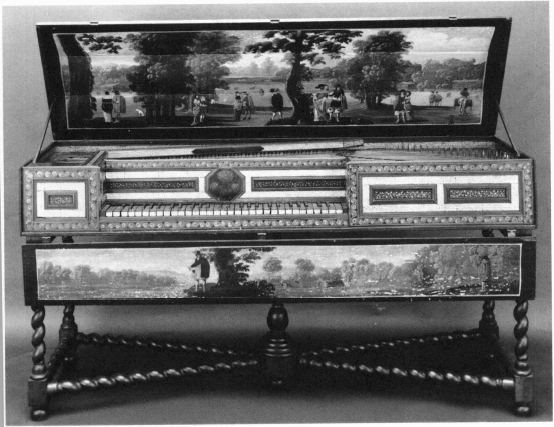
Fig. 239. Virginals by Adam Leversidge, London, 1666.
“A owld payre of virginalls” was the first instrument encountered in this search. It was found among the items listed in the household inventory of John Simson (fig. 240) who died in 1645. Simson came to Watertown, just to the west of Boston, in the Truelove in 1635 at the age of thirty with his wife, Susanna, and one child.46 Although his occupation and religious affiliation are unknown, one can assume that he was practicing husbandry, since the Massachusetts Bay Colony was primarily agrarian, and that he immigrated at this early date in pursuit of religious freedom.
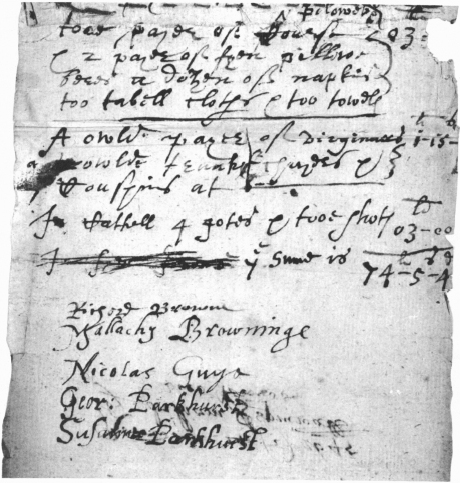
Fig. 240. Household inventory of John Simpson, Watertown, Massachusetts, 1645.
Passengers in ships like the Truelove were allowed room for little other than linen and tools. The virginal John Simson brought to Water-town was probably English or Flemish in origin. The instrument would have been rectangular in shape and simple in outward appearance. The decoration of seventeenth-century English and Flemish virginals is quite distinctive. When the lid is closed it is unadorned; when opened the interior is lavishly decorated with painted flowers and ornamental papers printed from woodblocks (see fig. 239). If the virginal was at eight-foot pitch it would have been six feet long; if it was at four-foot pitch it would have been four feet long. Simson was hardly a wealthy man; his estate was valued at only seventy-four pounds. To have brought a virginal with him probably meant the forfeiture of many necessities because of the limited space aboard ship, an action which speaks highly for the importance music had for him and his wife.
Edward Gibbons (d. 1654) was an “adventurer” and merchant. He is known to have spent some years among the pagan revelry at the “church of misrule” at Merry Mount, alias Mount Wollaston now the town of Quincy, following which, in 1630, he moved to Charlestown with Governor Winthrop’s company and settled into a stable family life.47 One cannot help wondering why a man of Gibbons’ temperament owned a virginal. Was he acquiring the apparatus of culture, or was he a musician? Gibbons was a shipowner and merchant. He could have brought it with him to the New World or he could have imported it at any time, but it is intriguing to consider whether the instrument might have accompanied him in Merry Mount.
The estate of Benjamin Richards (d. 1666), another virginal owner, was also small. Richards, a second-generation Bostonian, came as a small child with his family to Dorchester in the Mary and John,48 possibly along with at least one other instrument owner, John Pierce (d. 1661), who had a viol. Although Richards is identified in Table I as a merchant, in view of the small value of his estate he was probably a shopkeeper, or someone without a warehouse.
The value of the “Glas and chaires and a pair of Virgenals” set at £13.14, and owned by shipwright William Greenough (1641–1693) at his death catches the eye. Previous to this, the maximum value of a virginal was two pounds. Either the looking glass and chairs were especially valuable or Greenough owned a full-fledged harpsichord. The instrument was important enough to be one of only a few instruments specifically mentioned in a will:49 the owner’s daughter, Mary Stone, was the recipient. Although the gift of an instrument to a woman would suggest that she was a player, no further reference to this instrument has yet been found by the writer.50
Among William Greenough’s relatives and acquaintances there were several instrument owners. An examination of genealogical records shows him to have been related to at least three others connected with instruments. Nathan Rainsford (1641–1676), a cooper turned merchant and the brother of Greenough’s second wife, Elizabeth, also had a virginal. In 1690 Greenough’s son Luke was married to Abigail, daughter of Capt. Lawrence Hammond. Hammond’s journal for 1689 repeated in considerably more detail the use of a harpsichord in a curious experiment on the transmission of sound recorded two years earlier by Charles Morton (ca. 1627–1698), minister of the First Church, Charlestown, in his manuscript Compendium Physicae, 1687, the scientific textbook for Harvard College until 1728 (Appendix A).51 Did Hammond collaborate with Morton or duplicate this experiment as Hammond’s more detailed description suggests, and if so, to whom did the harpsichord belong that was used? Did Hammond, too, own a harpsichord, or was it the one documented in Greenough’s inventory? Did Nathan Rainsford own it earlier, or were these three separate instruments in all? Morton owned instruments too (see p. 474). That Morton knew the Greenoughs and the Hammonds is confirmed by the fact that he performed the marriage ceremony for Luke and Abigail.
Fig. 241. Portrait of Judge Samuel Sewall (1652–1730) of Boston, by John Smibert, Boston, 1729.
On December 1, 1699, ardent devotee of music, preceptor for Old South Church, and early diarist of Boston, Samuel Sewall (fig. 241), wrote: “Was at Mr. Hillers to enquire for my wives virginals: Mrs. Sarah Foster52 came to the Door.” How did Sewall, a second-generation Bostonian, acquire this instrument, and who was Mr. Hiller?53
It is well known that Sewall went to England in 1689 along with Thomas Brattle (1658–1713), who later purchased the chamber organ which bears his name. (See fig. 352 in Barbara Owen’s contribution to this volume.) Their musical experiences in England delight the reader of Sewall’s Diary and lead one to wonder whether Sewall might have returned from this trip with a virginal or whether it was imported for him at a later time. Had Mr. Hiller anything to do with its acquisition and/or was Hiller simply making repairs to it?
By 1713, within a decade of Sewall’s diary entry, the Boston selectmen had approved and admitted to the town its first legitimate dancing and music master, George Brownell (see Appendix C). Among the many professional services he proffered were dancing lessons and music lessons on the violin, flute, and spinet. This is an obvious indication that such instruments were at large in the community. Furthermore Brownell, who was skilled at “fitting and tuning” a spinet, leads the searcher to another contemporary spinet owner. A bill for his services rendered in 1714 and 1717 was addressed to “Mr. Stoddard Dṛ” (fig. 242). The owner, David Stoddard (1685–1723), was a merchant and stepfather to Brownell’s pupil Elizabeth Shrimpton iii (1702–1721).
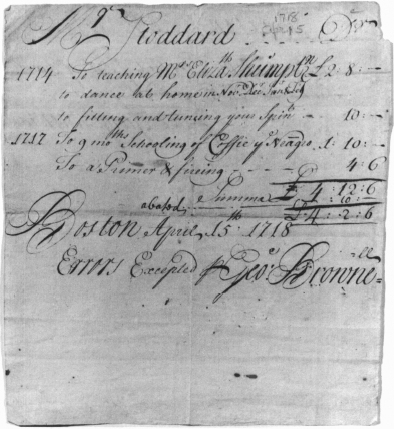
Fig. 242. ms bill for dancing lessons and tuning a spinet from George Brownell, Boston, 1718.
John Valentine, a Crown-appointed advocate general of the provinces of Massachusetts Bay, New Hampshire, and the colony of Rhode Island, was witness to David Stoddard’s will in 1723 (which was probated by Samuel Sewall). Valentine also owned a virginal. A year later, in 1724, Sewall referred to him as a “deserter” when Valentine hanged himself in his house.54 Beginning November 12, 1724, the Boston Weekly News-Letter carried for three weeks the following notice offering his virginal for sale:
Very good Gulick Hollands, to be Sold at a reasonable Rate for Ready Money, at the House of John Valentine, Esq; deceased: Where is also to be Sold a good pair of Virginals.
Were the Shrimpton and Valentine instruments two separate ones, or was the instrument referred to in Brownell’s bill as “a spinnet” perhaps purchased by Valentine in 1721 shortly after the death of Elizabeth Shrimpton iii either from her husband, John Yeamans, or her stepfather?
William Whittingham of Boston (ca. 1640–1672), a merchant and second-generation colonist, possessed a pair of “Virginalls wth a fframe” (fig. 243). His namesake and great-grandfather had been a well-known Puritan who defected from England at the time of Queen Mary’s reign. During the reign of Queen Elizabeth he returned and was rewarded with the deanery of Durham Cathedral, where he devoted himself to the cathedral song school and larded the choir’s repertory with songs and anthems from the Queen’s Chapel. The elder Whittingham was also a contributor to the Genevan edition of the Sternhold and Hopkins Psalter which included notation.55
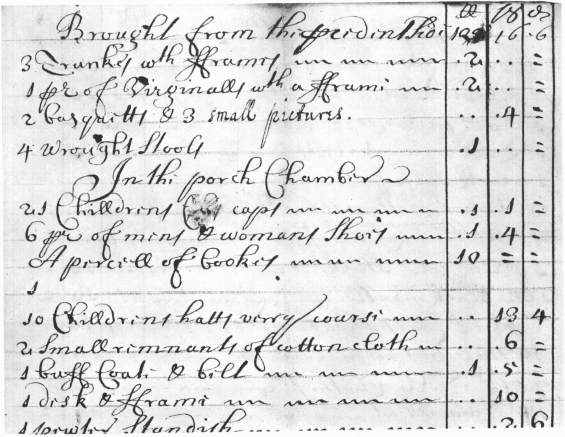
Fig. 243. Detail from the household inventory of William Whittingham, Boston, 1672.
plucked stringed instruments
Plucked stringed instruments were the most numerous instruments reported in the inventories but went all but unmentioned in other primary sources. This category of instruments includes 2 lutes, 4 guitars, and 22 citterns, or a total of 28 plucked stringed instruments in all.
William Whittingham is but the tip of another musical iceberg. His sister Martha married John Clarke, the well-known Boston physician (d. 1690), who had a guitar among his possessions. A cittern belonged to Samuel Haugh, pastor of the church at Reading (1621–1662), who in his will called Whittingham a nephew and appointed Samuel Sewall guardian of his two sons. And Peter Bulkeley, founder and minister of Concord, who called Samuel Haugh cousin, possessed 2 lutes when he died in 1659.56
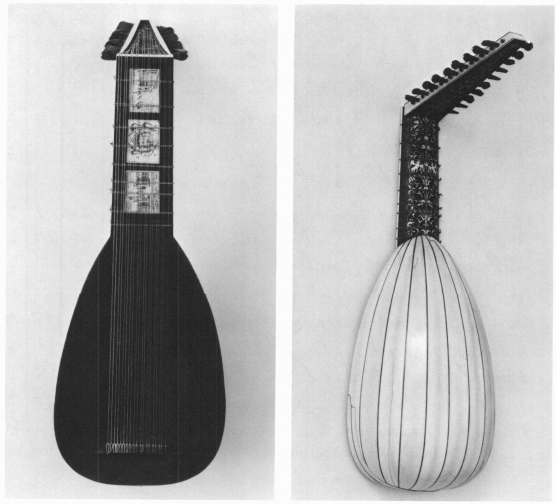
Fig. 244. Front and back views of a lute, ten courses, by Christofolo Cocho,? England, ca. 1640.
During the Renaissance the lute (fig. 244) rose to a position of unique importance which lasted until the end of the seventeenth century. An elegant and delicate instrument with its bowl-shaped back and angled neck, it had eleven to thirteen strings (six to seven double courses) which were traditionally plucked with the fingers; by this means it was possible to play several contrapuntal voices on it. For this reason it was ideal as a solo instrument and could provide a foundation or accompaniment for both instrumental and vocal music. In the sixteenth century neither a musician’s nor a gentleman’s training was complete until to some extent he had mastered the art of playing the lute.
The Puritan Peter Bulkeley (1583–1659) (fig. 245), who owned 2 lutes, was a true gentleman in this sense of the word. He would have been a youth during the lute’s golden age, around 1600. Cotton Mather said of him, “his education was answerable unto his originall; it was learned, genteel, and which was the top of it all, it was very pious.”57 As a Puritan gentleman he might have accompanied psalms from the Ainsworth Psalter,58 and played some of the exquisite lute songs and suites of John Dowland.
Although Bulkeley did not mention the lutes in his will, as one might expect, this need not detract from the importance they had held for him. It might only reflect their deteriorated physical condition. The lute was of especially delicate construction; its great number of strings placed considerable tension on the instrument’s thin walls. Lacking a stable climate Bulkeley’s lutes may not have withstood the voyage to New England or the rigors of life in the New World.
Fig. 245. Portrait of The Rev. Mr. Peter Bulkeley (1583–1659) of Concord, Massachusetts by an unknown artist, England, seventeenth century.
Thomas Mace in his Mustek’s Monument (London, 1676) prescribed the following care for the preservation of lutes in England (a moist climate, not unlike New England during part of the year, at least).
And that you may know how to shelter your Lute, in the worst of Ill weathers, (which is moist) you shall do well, ever when you lay it by in the day-time, to put It into a Bed, that is constantly used, between the Rug and Blanket; but never between the Sheets, because they may be moist with Sweat, &c.
This is the most absolute and best place to keep It in always, by which doing, you will find many Great Conveniences, which I shall here set down.
As, First, for the Saving of your Strings from Breaking; for you shall not spend half so many Strings as another, who lays their Lute open in a Damp Room or near a Window, &c.
2dly. It will keep your Lute constantly in Good Order, so that you shall have but small Trouble in the Tuning of It.
3dly. You will find that it will Sound more Lively and Briskly, and give you pleasure in the very Handling of It.
4thly. If you have any Occasion Extraordinary to set up your Lute at a Higher Pitch, you may do It safely; which otherwise you cannot so well do, without Danger to your Instrument and Strings.
5thly. It will be a great Safety to your Instrument, in keeping It from Decay.
6thly. It will prevent much Trouble, as in keeping the Barrs from flying Loose, and the Belly from sinking.
Now these six considered all together, must needs create a seventh, which is, That Lute-play must certainly be very much Facilitated, and made more Delightfull Thereby.59
Guitars were introduced to England from France in the seventeenth century and rose in importance until they eclipsed the lute just after 1700. The guitar (fig. 246) was of sturdier construction than the lute and therefore less temperamental, perhaps one of the reasons it was preferred. Descendants of the medieval gittern, guitars were double strung in gut and plucked with the fingers like the lute rather than with a plectrum as was their ancestor. Both of these factors permit the player greater nuance. The repertory was similar to that of the lute and included serious and difficult art music. Only the upper classes had the wherewithal to acquire them and the time to devote to their study.
Fig. 246. Front and back views of a guitar, five courses, by Jean Voboam, Paris, 1690.
The household inventories record 4 guitars among the colonists; 1 belonged to Comfort Star (1589–1660) and another to John Clarke (d. 1690), both surgeons by profession; 1 to John Foster (1648–1681), a Harvard College graduate, schoolmaster, and later the first printer in Boston; and another to Joshua Atwater, Jr. (1658–1692), son and namesake of the treasurer of the colony. Their professions and/or backgrounds indicate their place among the upper class and a high level of education; therefore it is not surprising to find guitars among their possessions. Although the instruments belonging to Star and Clarke were identified as “gitterns,” it is almost certain that they were guitars. The earlier name persisted into the seventeenth century when no gittern-type instrument is known to have been in use.
John Foster is of particular interest. He was the brother of the smith and soapboiler Hopestill Foster (d. 1679), who was recorded as having owned a drum at the time of his death in 1681, and of Sarah Foster who greeted Sewall at Mr. Hiller’s door when Sewall went to inquire about his wife’s virginal. In spite of his humble background John Foster was elevated socially as well as intellectually because he attended Harvard College and graduated in 1667. From 1669 until 1674 he taught Latin, English, and writing in Dorchester. In 1675 he purchased a printing press and became the first printer in Boston.60 He is also distinguished as the earliest portrait engraver in the colonies, and is reputed to have engraved the first map of New England (1677). He designed the arms for the colony of Massachusetts and for himself the handsome gravestone pictured in figure 247. In addition he was a mathematician and knowledgeable in astronomy.61
Fig. 247a. and b. Head and foot gravestones designed by and for John Foster (1648–1681) of Dorchester, Massachusetts, attributed to the Charlestown Stonecutter, 1681.
Fig. 247c. Grave headstone in situ, Dorchester (Massachusetts) Burying Ground.
Foster had ties with several other musically oriented personalities. He published the poems of Anne Bradstreet, whose works contain many allusions to music. Although he was almost a generation younger than her son-in-law Seaborn Cotton (1633–1686), minister of the church in Hampton (now New Hampshire), he may have known Cotton and his wife Dorothy (1656–1672), both of whom were poets. Cotton left a commonplace book which he kept throughout his life and which contained among other things the verses of a number of amorous and lusty secular ballads, which were then popular in England.62
It is interesting to note that the Cottons’ daughter Mary married in 1690 none other than Joshua Atwater, Jr., the guitar, cittern, and violin owner (fig. 248). Here then is another small enclave of educated music lovers and friends preserving the cultural tradition of art and music from the Old World while helping to tame the New England wilderness.
Citterns outnumber all other types of instruments in the inventories. The cittern is fig-shaped with a flat back and belly, and vertical sides (fig. 249), less fragile in construction than its cousin, the delicate bowl-shaped lute. The cittern was a practical instrument: it was strung in long-lasting wire rather than gut; it was easy to play and suitable for strumming; it served well as an instrument for accompaniment; and it was especially convenient to transport. In fact, three of the citterns were recorded equipped with cases.
Interestingly enough, of the 22 citterns found in the inventories, 8, or over one-third, were kept with or found close to the linen. Was this because the cittern was often played by women, or an indication that the instrument was tucked away, unused? Or, was the cittern frequently played and Mace’s advice about keeping the lute in good condition applied to the cittern as well?
Fig. 248. Household inventory of Joshua Atwater, Boston, 1692.
The use of the cittern in the eighteenth century was quite different from that in the seventeenth. As the cittern rose in popularity, so the lute declined. In the late sixteenth and first half of the seventeenth century ingenious parts were written for it in England by Thomas Morley and Philip Rosseter, published in their Consort Lessons; and Antony Holborne as well as Thomas Robinson wrote substantial pieces for it. In London, too, in 1666 John Playford published his Mustek’s Delight on the Cittern in which he attempted to refine and elevate the instrument by encouraging performers to use finger technique and discouraging the use of the plectrum. But in serious music its day was waning, and the cittern succumbed to the cheerful and noisy strumming to which it was without doubt subjected in the homes, taverns, and barbershops of the colonists during the last half of the seventeenth and early eighteenth centuries. Its nearest modern equivalent in timbre today is the mandolin.
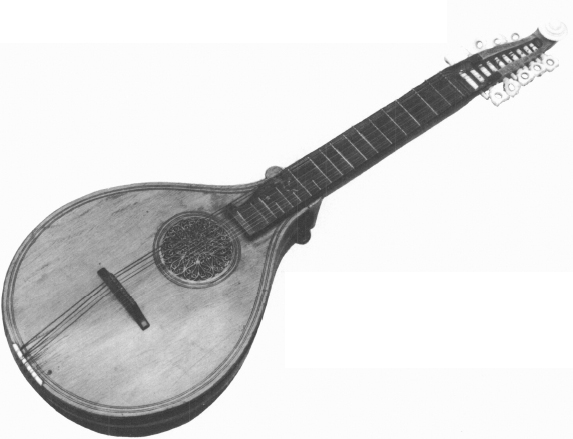
Fig. 249. Cittern, five courses, Italy or Germany, late seventeenth or early eighteenth century.
Although the cittern was chiefly the favorite of the middle class, cittern owners represent a wide variety of occupations and incomes. The value of the estates in which citterns were listed is revealing: 7 were under £200, 10 fell between £200 and £1,000, and 4 were above £1,000. But what about the occupations of the cittern owners? Yeomen and mariners top the list; there were 6 of each. There were 2 ministers, 2 merchants, 1 physician, 1 shopkeeper, 1 “taylor,” 1 “brickburnor.” Among these owners were 2 women.
Elizabeth Holloway owned a cittern at her death in 1680. She appears to have been a woman of considerable business acumen; while providing for her six children and tending her yard goods shop in Boston, she was able to double the estate of her husband, who died in 1664. Because his inventory was not found it was impossible to determine whether a cittern might have been among the family’s possessions when they immigrated shortly before William’s death,63 or whether they might have acquired it afterwards. Elizabeth’s enterprising nature may have inspired her to purchase a cittern with which to entertain her children and to accompany the family psalm singing.
Upon his death in 1677 Ralph Day left a cittern (fig. 250) to his only daughter, Abigail. (He also left a drum to his son Ralph Day.) His will reveals a strict, self-righteous man.64 Although no further trace of Abigail can be found, Day’s bequest of the cittern to his daughter would seem to coincide with the attitude of his contemporary Leonard Hoar (ca. 1630–1675) who thought that that music was more appropriately the province of females.
That the playing of music was deemed appropriate for women was indicated in a letter from Leonard Hoar, future president of Harvard College.65 Writing from London in 1661 in reply to a request from his nephew Josiah Flynt (1645–1680), a freshman at Harvard College, Hoar explained:
Howbeit, hearing your mother’s desires were for it, for your sisters, for whom it is more proper, and they also have more leisure to look after it; for them, I say, I had prepared the instruments desired, but I cannot now attend the sending of them, being hurrying away from London by the unexpected providence of your uncle Daniel’s sickness, which, with some other circumstances do not a little distress me.66
Fig. 250. Household inventory of Ralph Day, Dedham, Massachusetts, 1677.
From the same family also comes evidence that the gentlewoman mentioned in Hoar’s letter (his sister Marjory Hoar Flynt, mother of Josiah) may have been teaching music. In 1742 Tutor Henry Flynt, Josiah’s son, composed an epitaph for a new gravestone he was having cut for his grandmother Marjory Hoar Flynt, who had died in 1687. That epitaph celebrated her as “a gentlewoman of piety, prudence, and particularly accomplished for instructing young gentlewomen, many being sent to her from other towns, especially from Boston. They descended from ancient and good families in England.”67 Perhaps the instruments Leonard Hoar sent from England to his sister in Braintree, Massachusetts, were also intended for use in her curriculum “for young gentlewomen.”
Mention of a dulcimer was made only once during the period under consideration. Samuel Sewall, on his return to Boston from Salem, recorded one on May 23, 1717: “Lodge at Cousin Porter’s: See and Hear the Dulcimer.” Cousin Porter was the Rev. Aaron (1689–1722), graduate of Harvard College, 1708, and husband to Sewall’s niece Susanna.68
The dulcimer (fig. 251) was a trapezoidal sound box over which some nineteen to twenty-eight multiple courses of wire strings in graduated lengths were stretched. The strings were tuned diatonically and played by striking them with light wooden hammers held in each hand. Repeated striking of the strings in quick succession was required to sustain notes, resulting in an exciting rhythmic sound. A precursor of the piano, the dulcimer made a sweet bell-like sound not unlike the cittern’s except in articulation.
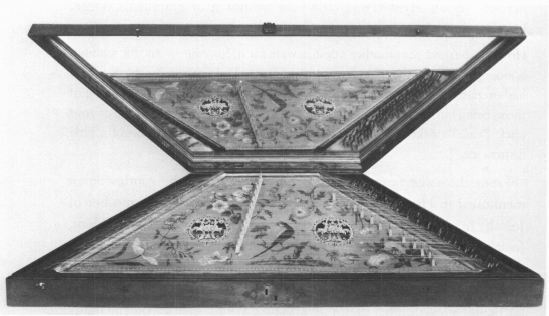
Fig. 251. Dulcimer, twenty-four courses, by an unknown maker, France, first half of the eighteenth century.
It is not known whether the Porters were the owners of this dulcimer Sewall witnessed. Sewall was a frequent visitor to their house, yet this was the only time he mentioned the dulcimer. Perhaps it was new to the family in 1717 and therefore Sewall was compelled to mention it, or perhaps it belonged to another guest of the Porters who was visiting at the same time as was Sewall.
bowed stringed instruments
Of bowed stringed instruments the Massachusetts Bay colonists possessed both viols and violins. Violas da gamba, or the family of knee viols (as contrasted with the violas da braccio or arm viols such as the violin and its family), had been in use since the Middle Ages. They gave forth a soft yet penetrating sound that was reedy yet subtle and refined. Viols have six gut strings tuned in intervals of a fourth (while the violin has four gut strings tuned in intervals of a fifth), fretted fingerboards (the violin’s fingerboard is unfretted), sloping shoulders (compared with the violin’s rounded ones), high sides (the violin’s sides are lower in proportion), and a much lighter construction than that of the violin (fig. 252), which gives the viol’s sound its delicate poignancy. The viol was a favorite of the English aristocracy during the Renaissance and the early Baroque. Its ensemble (consort) music was sober, abstract, and highly intellectual. The mere possession of a viol implied an exceptional degree of musical understanding.
Nineteen viols have been documented among the colonists: 3 treble and 7 bass viols were specified (see fig. 252), while the sizes of the remainder were unspecified. For the performance of late seventeenth-and eighteenth-century music the bass was eminently versatile because it could be used to play not only solo and chamber music of some complexity but also a more modest continuo part along with a keyboard instrument to accompany psalm singing.
Four persons associated with viols were ministers, 2 were schoolmasters (one of whom was the printer John Foster aforementioned), 2 were husbandmen, and 1 was a merchant and treasurer of the Massachusetts Bay Colony. The common denominator among these owners is the high level of education implied by their occupations. Given that viol playing connotes an educated musician, it is not surprising to find viols among their possessions.
The Rev. Edmund Browne (1606–1678) was a founder of the town of Sudbury (the old center of which is now incorporated in Wayland) and the first minister to its church. A graduate of Cambridge University, he was a scholar, a gentleman, and a divine. On the basis of his existing wealth he was granted the largest parcel of land among the settlers and held in high social and religious esteem.
Both his inventory and the Sudbury town records show him to have been a man not unaffected by worldly possessions. His inventory included “Anjrons, with broad brass Eschucheons, fire shovell, tongs, & six high leather chayres,” “1 Greene Plush Sadie, case & crupper,” and a study containing 180 books. The town records document considerable strife in the village over land issues. After considerable aggravation Browne took a prominent part in the heated debate and finally used the church politically to protect his own property.
Although not listed separately in his inventory, a schedule “annexed” to his will detailed the disposal of certain of his possessions. Among those items kept in his study were “my base voyall, with all my musicall bookes & instrumts with all my fishing craft” which he left “to my loveing friend Thomas Walker” (fig. 253).
Upon graduation from Cambridge University in 1624, Browne returned to his native Sudbury in Suffolk, England, a stronghold of Puritanism.69 There he assisted in one of the large churches and took up the bass viol. Later, in New England, the viol was probably used to accompany the social singing of psalms or to entertain his friends.
The use of the viol for after-supper entertainment was recorded by the Rev. Peter Thacher of Milton (1651–1727) in his diary entry for the 6th of December 1681: “m Dimmuck Goodm. Troup, Goodm. Parker & little fuller, James Hamblin were to see mee. ys day yy Cut & Carted wood for mee in milton, yr was Eleven Carts, 18 Cutters of wood / I made a supper for ym wee had ye Viol afterward.”70
Violas da gamba were frequently played “in consort.” “Consort” was the seventeenth-century term for an instrumental chamber ensemble. The music of such consorts was, as already mentioned, a serious, highly intellectual counterpoint or a complex interweaving of melodies or parts, one instrument to a part. Consorts were either “whole,” consisting of different sizes of instruments of the same family, or “broken,” made up of several types of instruments. Browne’s phrase “all my musicall bookes & instrumts” suggests that he owned consort music. Could the “instrumts” have been flutes or recorders, small instruments not valuable enough to have been specified, but upon which various parts of the music could have been played to make up a broken consort? Browne corresponded with the Rev. Peter Bulkeley in Concord over the Sudbury village land controversy. The Rev. Thomas Shepard of Charlestown (1635–1677) had been Browne’s classmate at Cambridge University. Bulkeley, it will be remembered, owned 2 lutes, while Shepard possessed a cittern. The combination of cittern and viol could have been well satisfied by Holborne’s Cittharn Schoole (London, 1597). These instruments would have made up a broken consort upon which the works of Coperario, Lawes, Locke, and others may well have been played.
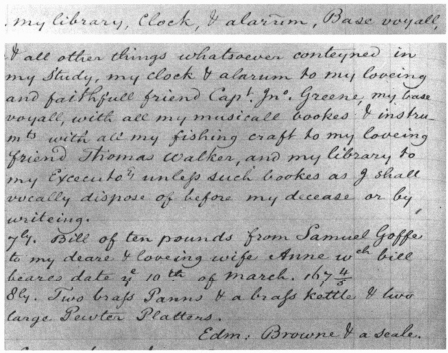
Fig. 253. Detail from the will annex of the Rev. Mr. Edmund Browne of Sudbury, Massachusetts, 1678.
The combination of instruments owned by the Anglican schoolmaster Samuel Grainger (1686–1734) also suggests consort playing, and causes one to wonder if he might have been teaching music. His inventory of 1734 lists “1 spinett, 4 base viols, 2 broken Instrumts 15———” (fig. 254). The “broken instrumts,” of course, could be other unidentified instruments in a state of disrepair, or 2 instruments other than viols used in consorts, hence the term “broken.” But what was Grainger doing with 4 bass viols? Was Grainger giving instruction on them, or was he dealing in musical instruments? (See Appendix C.)
Grainger emigrated from London. Having petitioned the selectmen, he was licensed to open a school in Boston. On February 29, 1720, an advertisement for Grainger’s school appeared in the Boston Gazette (fig. 255). It suggests that he offered at least one musical activity after school hours. Grainger’s skills in teaching grammar, writing, accounting, and mathematics were highly regarded.71 Another piece of evidence that Grainger was teaching music is an entry in Benjamin Wadsworth’s account book and diary. Boarding with Wadsworth was John Turner, a student of Grainger’s. Sandwiched between tuition payments made by Wadsworth to Grainger on behalf of Turner was the entry “Feb.24. 1721/2 for a singing Book 00–00–06.”72 One can never be certain whether the “singing Book” was purchased for the pupil’s participation in a newly formed singing school, or whether Grainger himself was teaching his students to “sing by note” as part of his school’s curriculum. If the latter, perhaps he was also offering instruction on the bass viol, a handy instrument to accompany singing.
Fig. 254. Page from the household inventory of Samuel Grainger, Boston, 1734.
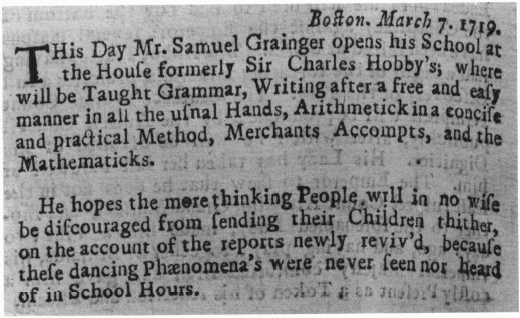
Fig. 255. Advertisement from the Boston Gazette, February 29, 1720.
Grainger may also have been dealing in instruments. After Edward Enstone resigned as organist at King’s Chapel in November of 1723 and sold his house and movables, he used Grainger’s school to teach dancing until probably sometime in 1724, when he seems to have left Boston for good. Enstone was a music master and a dealer in musical instruments as well. It could be that Enstone left or sold some of his stock to Grainger before removing to other parts.73
Fig. 256. Detail from the household inventory of the Rev. Charles Morton, Charlestown, Massachusetts, 1698.
Another distinguished viola da gamba owner among the colonists was the Rev. Charles Morton (ca. 1627–1698). His inventory (fig. 256) listed “2 Base Violls, one at 20ṣ yẹ other at 10 pe 01:10:00” and “3 old Viall Inns at 6 pe each 00:18:00.” Morton, the recipient of an m.a. from Oxford University, had been a rector and schoolmaster in England. He emigrated in 1686 with the expectation of becoming president of Harvard College but his hopes were dashed because his politics were not in sympathy with those of Governors Dudley and Andros. Instead he undertook the ministry of the church at Charlestown, succeeding the late Rev. Thomas Shepard, the son of the cittern owner. As was mentioned earlier, Morton’s manuscript Compendium Physicae revolutionized the study of science at Harvard College. Because of his close proximity in Charlestown, he was frequently consulted in both theological and scientific matters, and he exerted considerable influence among the educated community. In 1692 Morton was elected a fellow at Harvard College and in 1697 he became the first vice-president of Harvard.74
It is frustrating to peruse Sewall’s Diary, which so clearly bespeaks the writer’s passion for music, to come upon entry after entry describing the close association between Sewall and Morton, and yet find no mention of their musical companionship. Of the 2 viols Morton owned upon his death the value of one was twice that of the other. It was and is common for an active musician to own a good instrument and an everyday instrument; the evidence suggests that Morton was a practicing musician and that he did not care to be left in the colony without an instrument to play on. His library valued at forty-five pounds must have been a large one.75 One suspects that Morton’s library, like the Rev. Edmund Browne’s, also included consort music which certainly would have appealed to a gentleman of letters such as Morton.
The violin or fiddle was primarily a Baroque instrument. Although it attained its definitive shape about 1500, it was not generally utilized in serious music until at least a century later. Until the period with which this study is concerned it made its way with difficulty. Musicians considered it fit only for dance music. Acceptance by serious composers came gradually in the course of the seventeenth century, and during the Restoration the lowly popular violin began to supplant the viol in serious music.
Colonists arriving after the middle of the century, although they might have been acquainted with the music of such eminent English composers as Jenkins and Locke, seem to have found their own violins more useful to strike up a dance. While there are numerous references to violins and dancing, there is only circumstantial evidence to support their use in chamber music. Charles Morton, however, with his 3 “Viall Inns” was an amateur musician who might have played the new consort music on his violins as well as his viols. Perhaps he lent them to friends who stopped by his house in the evening to share in a musical repast. (See p. 448 for some of his musical acquaintances.)
Joshua Atwater, Jr., owned “two violins at 15s a peice 1:10:00” in addition to his “two cittorns & one gittorn 00:10:00” already mentioned (see fig. 248). He too was almost certainly using his violins for consort playing. The combination of Atwater’s instruments with a bass instrument such as a viol was ideal for the music of Lawes and Playford as well as Locke and Jenkins.
Most of the other violin owners, with the possible exception of Governor William Burnet (to be discussed), were probably using their instruments to accompany dancing or to play popular tunes. The violin was the ideal instrument with which to accompany dancing. It was small and permitted the fiddler to call out and demonstrate dance steps while providing the music, and the tone was penetrating enough to be heard above the shuffling of feet. The violin’s association with dancing among the colonists is well established. A Salem Court record of 1679 documents one misuse of the violin with dancing in a public house:
Petition of John Willkison: [autogr.] that he had been sent for to answer for excessive drinking and keeping bad order in his house, which charge he denied, and asked to see his accusers to find out if the charges were not made on prejudice, etc.
Mary Indicot, aged about twelve years, deposed that she saw fiddling and dancing in John Wilkeson’s [sic] house and Hue drinking liquor there.
Margat Dowling, aged about eleven years, deposed the same.
Hew Galloway, aged about 22—years, testified that they asked him to fetch a quart of rum and the next morning they wished to borrow a half crown of him. He bought a quart and drank it there and drank and paid for another quart at Wilkensun’s [sic] house the next morning.
Sworn 7:8:167976
To prohibit such disturbances, in 1646 a colonial law had been passed against dancing and gaming in ordinaries or public houses. The law read in part:
Upon complaint of the disorders, by the use of the Games of Shuffle-board and Bowling, in and about Houses of Common-entertainment, whereby much precious time is spent unprofitably, and much waste of Wine and Beer is occasioned; . . . Nor shall there be any Dancing in Ordinaries upon any occasion, on the penalty of five shillings for every person that shall offend; and any Magistrate may hear and determine any offence against this Law.77
The fact that a law was passed against dancing in public houses indicates that it was not an infrequent occurrence. And if there were dancing, one can be almost certain that there were fiddles.
Furthermore, although the law prohibited dancing, it said nothing about music or playing of instruments. It has already been noted that it was common practice to keep small instruments such as citterns in ordinaries for the entertainment of guests. Violins were without doubt in the same category.78
Two violin owners were taverners. One was William Bryant (d. 1697), about whom little is known. His violin with its case was kept “In the little Chamber” in his house, a room which from its contents appears to have been a parlor, along with “3 Joynt Stooles 6.s . . . & 2 pictures 20/all [total] 1.6.–.”
Samuel Kendall (d. 1711), whose inventory also included a violin (see fig. 402), petitioned for an innkeeper’s license at the Green Dragon Tavern (see fig. 403) upon his arrival in Boston. The town records report that Kendall petitioned four times before a careful check on his character was completed and a final negative decision handed down by the selectmen on October 29, 1705:
The Select men considering the Notification they have this day reed, from the Court of Genll. Sessions of the Peace Signifieing that they do Allow Samll. Kendall to be an Inholder at the House comonly Called ye Green Dragon unless the Select men have Objections to the contrary. The Sd. Select men do their fore Signifie to Sd. Court, that (he being a Stranger) they have made enquiry concerning him, & finding the Charecter given of concerning him not to be Encouraging did formerly disallow his Petition and Since being enformed that he hath Lately been Convict of Keeping bad orders in his House they are of Opinion that he is not a Sutable person to be admitted to keep a Tavern in this Town.79
Kendall’s third petition had been made for him by the tavern’s owner, Madam Thomas Cooper, formerly Mehitable Minot, who in 1715 took for her third husband Simeon Stoddard (1651–1730). In 1714 the schoolmaster George Brownell had tuned a spinet and given dancing lessons in the house of Simeon Stoddard’s son David (see fig. 242).80
It will be recalled that Josiah Flynt wrote to his uncle in London in 1661 requesting musical instruments for his mother and sister; the second part of his request was for something musical for himself (exactly what is unclear). The uncle, Leonard Hoar, replied approvingly with regard to instruments for the women, but his response to Josiah’s request was firmly negative, advising Josiah to apply himself instead to studies which in the end would prove more profitable. Leonard Hoar’s answer was based on the Puritan “gospel of work” ethic which in reality considered one’s economic and social advancement to be almost on a par with spiritual salvation and the ability to reason elaborately:
Music I had almost forgot. I suspect you seek it both too soon and too much. This be assured of, that if you be not excellent at it, it is nothing at all; and if you be excellent, it will take up so much of your time and mind, that you will be worth little else. And when all that excellence is attained, your acquest will prove little or nothing of real profit to you unless you intend to take up the trade of fiddling. . . .81

Fig. 257. Advertisement from the Boston Gazette, September 11, 1727.
Josiah’s advancement, Hoar felt, would be inhibited or lost if Josiah were to concentrate his efforts on music. In the last phrase of the quotation Hoar dismisses Josiah’s musical inclinations with the sarcastic remark that of all the musical endeavors Josiah might undertake, fiddling was the only income-producing possibility.
An advertisement from the Boston Gazette for September 11, 1727, revealed, however, just how slim the income might be if one were to apply oneself to the trade of fiddling (fig. 257). This advertisement also provides the reader with a glimpse into private dances or “frolicks.”
But the fiddler wasn’t always a hired “professional.” Capable amateurs sometimes provided for their friends’ dances. Benjamin Lynde, Jr. (1700–1781), made note in his diary of the many dances he attended as a youth. One instance, noted here, involved Lynde’s cousin and close friend William Browne (1709–1763), an amateur fiddler who was from the wealthy Salem family of merchants:
March 23d, 1730. Fair wind; At night rid on W[illiam] B[rowne]’s horse; after, he down here playing on his violin.82
Although riddling at dances was not considered a proper vocation for a man of Browne’s social standing and education, no doubt William in his youth enjoyed playing for dances and entertaining his gay social set of Essex County merchants.
Upon the death of his father in 1737 William Browne (fig. 258) came into possession of a family house and an inheritance. Almost immediately he sought and won the hand of Mary, daughter of the resplendent royal Governor William Burnet who had died in 1729 leaving a handsome collection of instruments.
By the close of the period under discussion, many men of means had found it desirable to have a servant or an indentured member of the household with a talent for making music. There were frequent newspaper notices about servants skilled in music who had either fled or were being offered for sale. The following notice from the December 2, 1734, issue of the Boston Gazette was not uncommon for the times:
A Negro Boy of a gentle Behaviour, who plays exceedingly well on the Violin, (I may venture to say none of his Colour can exceed him here) To be Sold. He is a valuable Boy on other accounts, and undoubtedly worth much more than what he may be bought for. Nothing but an Honest Disposition in the Owner wou’d tempt him to part with the Boy: Inquire of John Boydell [Gazette editor].
Violins, too, were now prized instruments and often the object of theft. Again Boston newspapers recount the circumstance. The Boston Gazette of February 1, 1731, reported:
Whereas on Friday Night last the 5th Currant [sic] the Warehouse of Mr. Joshua Winslow (with sundry others) was broke open, and there was stolen from the said Winslow’s Warehouse, about thirty pair of Mens Spanish Silk Stockens, two or three Dozen of Womens Fans, sundry pieces of garlick, a Lads Fiddle or Violin, and a pair of Skates: These are therefore to desire all persons that in case the Goods aforesaid or any of them should be offered to Sale, and can be discovered, that the same be Stopped, and Notice thereof given to Edward Winslow Esq; in Boston, that the Person or Persons concerned in committing the said Fact may be apprehended and prosecuted as the Law directs, and all reasonable Satisfaction shall be made to any one who shall make discovery as aforesaid.
Fig. 258. Portrait of William Browne (1709–1763) of Salem, Massachusetts, by John Smibert, Boston, 1744.
wind instruments
Twenty-eight wind instruments were located. Included in the list are 5 fifes, at least 6 flutes, 1 curtal, 1 mock trumpet or early clarinet, and 15 trumpets; to which might be added a minimum of 21 jew’s harps.
There is continued dispute over whether the jew’s harp (fig. 259) is an idiophone, an instrument whose sonorous substance is the primary vibrating medium; or an aerophone, a wind instrument sounded by a free metal reed.83 It is played by grasping between one’s teeth the metal frame which holds the reed and vibrating the reed by plucking it with one’s finger; pitch is controlled by varying the shape of the mouth which acts as the resonating chamber.
Mention of single instances of jew’s harps are rare; when cited they usually appear in quantity. Three lots of jew’s harps surfaced in the inventories. “1 doz. 7 Jues harpes” valued at “1s 7d” were among the possessions of Samuel Andrews (d. 1659), a shopkeeper newly come to Middlesex County. An unspecified number of jew’s harps valued at “6s” were found along with “thimballs 1s6d sizars 8s Horn Combs 7s” among the items from another shop belonging to Jonathan Cleasby (d. 1695) of Charlestown.
The colonists had at least three uses for jew’s harps. First, they were traded with the Indians. There is, for example, the evidence of embezzled property sworn on August 28, 1653, and submitted to the Salem Court, Essex County, Massachusetts: “. . . Seventeen dussen of Jews harpes, 3li 8s; . . . twelve dussen of bells, 1li 4s; these things were prized as they were sould to the Indians. . . .”84 Second, they were often used by children. From a later era comes a description by Edward Everett of the desk of his Boston schoolteacher John Tileston: “his long deep desk was a perfect curiosity shop of confiscated balls, tops, penknives, marbles and jews-harps, the accumulation of fourty years.”85 And third, there is suggestive evidence that adult colonists themselves played the jew’s harps. Robert Dixon, a “traider” from Concord, had “2 Jews harps and 1 old Violoan & case” in his possession when he died in 1724.
Fig. 259a. Two iron jews harps, seventeenth or eighteenth century.
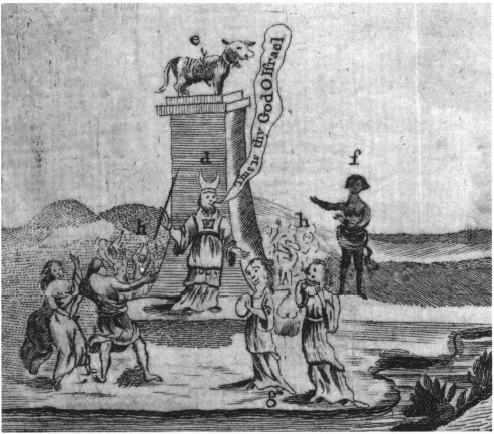
Fig. 259b. Detail of jews harp player facing page 15 of a pamphlet attributed to William Billings, The Porcupine, alias the Hedge-Hog: or, Fox turned Preacher, Boston, 1784.
The only wind instrument other than trumpets that appeared in the inventories before 1696 were two lots of 5 fifes in all. The Swiss infantry fife was introduced into England in the beginning of the sixteenth century. From that time until the twentieth century, fifes have been used in the standard corps music ensemble: the drums kept time and gave signals, while the fifes added melodic interest.

Fig. 260. Fife by William Callender, Boston, 1789–1838.
The fife of the period under discussion was sideblown (fig. 260). It was a single piece of wood with a cylindrical bore, mouth hole, six finger-holes, but no thumbhole, all arranged in a straight line along the side of the pipe. Simple in design, it would have been a relatively easy instrument to make, especially for a turner. Because of its usefulness and because of its simple form, it would not be surprising to find a fife maker early in the history of the Bay Colony.
The first fifes were found in the inventory of Arthur Clarke of Boston, who died in 1665 (fig. 261). Clarke had “3 fifes & to duzen of trenchers & to Chaieres” valued at seven shillings six pence the group, and twelve shillings’ worth of “Carpenteres tolles.” Because of the tools identified in the inventory it is reasonable to assume that Clarke was a woodworker. Although his estate was valued at a modest “71„19„6” it included “latton bookes & a bibles” and he was listed among the members of the First Church. Perhaps the unspecified carpenter’s tools were those of a turner and the fifes listed in the inventory were actually made by Clarke. If so, he is one of the earliest instrument builders in the Massachusetts Bay Colony.
Fig. 261. Detail from the household inventory of Arthur Clarke, Boston, 1665.
Richard Gridley (d. 1674), a brickmaker by trade, arrived in the New World probably as early as 1631 and rose to become captain of the Artillery Company.86 He had 2 fifes among his possessions at the time of his death in 1674. His inventory reveals the purpose to which he put them: “It. by his arms he traynd with & 2 fifes & 2 Chests & still 3 cases with 3 or 4 botells in them & a small [erasure] 2„05„–.”
The term flute originally encompassed a wide variety of wind instruments. By the seventeenth century the word most commonly referred to fifes, transverse flutes, or recorders. Seventeenth-century transverse flutes were similar to the fife, Renaissance in style, but were larger and therefore lower in sound.
John Dyer, an ironmonger who died in 1696, owned 2 flutes. Both Dyer and his brother were active in military service. John Dyer served as a member of Capt. Daniel Henchman’s military company in 1680, then in that of Capt. John Wing in 1684; in 1691 he was inducted into the Artillery Company.87
Found among the items in his shop were “2 glovers sticks 16d 2 flutes 2s 1 doz ½ Cork Screws 2s.” His “flutes” could have been fifes, recorders, or transverse flutes. Dyer was a second-generation colonist who died at the relatively advanced age of fifty-three. Because the English did not adopt the new flute of French design until the advent of the eighteenth century, it is highly unlikely that Dyer was in possession of either Baroque-type flutes or recorders. It is more probable that he owned the keyless, single piece Renaissance-type flutes or fifes. As a military figure, he may have played the fife, or he may have been stocking them to sell to other militiamen.88
Charles II established a band of twenty-four violins at his court in the latter half of the seventeenth century following the example of Louis XIV at Versailles, and thereby heralded the beginning of the modern orchestra. Its effect on wind instruments, as well as stringed instruments, was revolutionary. The families of instruments were reduced and standardized; the ranges of the individual instruments were increased, upwards for those of higher voice, downwards for those of lower; and performers were encouraged to concentrate as virtuosos on one instrument rather than play well on several.
During the Baroque period, the advent of the orchestra brought about several changes in the flute. The Baroque flute’s bore was changed from cylindrical to conical, extending its upper register and improving its intonation, although weakening the quality and strength of its lower register. By the early eighteenth century a fourth section or joint had been added in compensation for this loss, and a seventh hole covered by a key was added at the end of the flute. At the same time alternate second joints were sometimes provided for more radical changes in pitch. Recorders, endblown and fitted with embouchures in the form of beak-enclosed windways, underwent similar transformations.
Eighteenth-century owners of flutes were Walter Rosewell, a sea captain who died in 1717 on board his ship with “1 Flute & book”; James Scolley, a shopkeeper who died in 1721 leaving “3 canes, 1 fflut, 1 Glass Lanthorn 2„–„–”; and Increase Gatchell, a Boston dancing master who died in 1729. Whether recorders or transverse flutes, these instruments were probably the newly designed Baroque types (fig. 262 a, b, and c).

Fig. 262a. Transverse flute by Jacopo Neni, Italy, ca. 1600.

Fig. 262b. Transverse flute by Peter J. Bressan, London, ca. 1710.

Fig. 262c. Treble recorder by Peter J. Bressan, London, ca. 1710.
Fig. 263. Page from the household inventory of Increase Gatchell, Boston, 1728.
Increase Gatchell, a Boston schoolmaster left “a parcell of Cattgutts. flutes. 1 pṛ of Skaits & a mock Trumpett 1„–„–,” “1 Tankard. Bord. and. 1 Fidle 1„10„–,” in addition to his “1 Harpsicord 10„–„–” (fig. 263). Gatchell left more clues about how he used his instruments than did earlier instrument owners.
Nothing is known about Gatchell before he married Elizabeth Calef (or Calfe) in 1722. On March 4, 1723, the New-England Courant carried an account relating to his activities as a dancing master (fig. 264; see also Appendix C). The newspapers carried no further references to Gatchell’s dancing school for the year. Whether the unruly youths discouraged Gatchell from holding classes, or they ceased their disturbances, music remained a part of his livelihood.
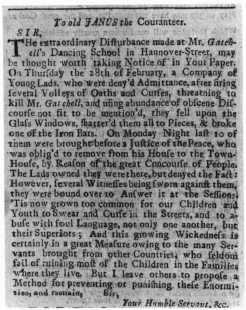
Fig. 264. Report of a disturbance from the New-England Courant, March 4, 1723.
On May 25 and again on June 1, 1724, he placed a modest advertisement in the New-England Courant which read: “Choice good Italian Fiddle-Strings, to be sold by Increase Gatchell in King-Street.” Could the unspecified number of flutes listed in his inventory also have been part of his stock-in-trade?
Certainly Gatchell’s “fidle” was essential to his occupation as dancing master; paired with a tankard it further suggests that Gatchell may have provided entertainment in ordinaries where often one was expected to bring one’s own drinking vessel. And the high value of ten pounds placed on Gatchell’s harpsichord almost certainly identifies it as a full-fledged wing-shaped instrument. Further description of this type can be found on pages 442 and 504 in this study. Although the letter of administration to Gatchell’s estate refers to him as a “schoolmaster,” one can assume that he was probably giving instruction on harpsichord, fiddle, and possibly flute.
Fig. 265. Mock trumpet by Stuehnwal, ca. 1700.
Gatchell also had “a mock trumpett” (fig. 265). The “mock trumpett” or chalumeau, although a single-reed instrument, was actually derived from the recorder. It was a small instrument, from twenty-two to twenty-five centimeters in length, and had a cylindrical bore. Its sounding mechanism was a single reed tied against a hollow, beaked mouthpiece against which it beat in the manner of its descendant, the clarinet. The mock trumpet had seven fingerholes in front, a thumbhole in the rear, and sometimes one or two additional key-covered holes near the mouthpiece. Although its range of one octave plus one to three notes was limited, its register was high, and the quality of its sound likened it to the clarino or highest register of the true four-octave trumpet,89 hence the name “mock trumpet.” The first book of music composed specifically for this instrument was published in London in 1698. The instrument enjoyed a brief popularity during the next fifty years and a number of composers continued to write music for it throughout the eighteenth century. The mock trumpet, then, for a jack of all trades like Gatchell, would have been an ideal solution for providing a trumpet sound and register on a comparatively easy instrument, one whose range was interchangeable with the alto recorder and transverse flute, permitting access to a wide variety of music. Gatchell’s possession of this instrument would also indicate that he was quite up-to-date with the latest English and Continental musical inventions and developments.
Fig. 266. Natural trumpet by William Bull, London, ca. 1700.
trumpets and drums
The natural trumpet was the aristocrat of musical instruments. Its heroic spirited sound has long been associated with power and officialdom. The natural trumpet (fig. 266), usually of brass, sometimes of silver, consisted of a narrow cylindrical tube of over seven feet in length ending in a flared bell. When folded twice, the trumpet was reduced in length to approximately twenty-seven inches. Having no slides, valves, or keys, the natural trumpet required a highly developed lip technique of its player.90 In Western Europe, the use of the natural trumpet, whether civil, military, or purely musical, was exclusively granted to the church and state and the privilege of playing it was regulated by guilds.
Although no specific regulations were discovered restricting its use in the Bay Colony, most of the trumpets identified were associated with colonial government officials or those of the Crown. (For a chronological listing of primary source references, see Appendix B, “Civic Announcements.”) In addition, there was the overlapping category of trumpet playing aboard ships.
Although the primary focus of this study is concerned with secular social music, several examples of the trumpet’s military and political use will be touched upon here. The “doleful noise of trumpets and drums” was heard and described at the funeral procession of Deputy Governor Francis Willoughby in 1671, where the trumpets were probably muted and the drums muffled by black shrouds as was customary at funerals. In 1687 Samuel Bligh was one of two trumpeters who accompanied the unpopular governor Sir Edmund Andros upon his removal from Boston to Connecticut. In 1699 trumpets were summoned for a procession to herald the arrival of the new governor, Richard Coote, the Earl of Bellomont. Twice in 1697 trumpets were cited, once proclaiming the king’s birthday, and once announcing the end of King William’s War in America and the Peace of Ryswick Treaty among France, England, Spain, and Holland. A black trumpeter named Nero Benson was attached to Capt. Isaac Clark’s Company in Framingham. And in 1724 “Thirty-two Principal Barbers of this Place [Boston], assembled at the Golden Ball, with a Trumpeter attending them” to decide whether or not they should raise their prices.91
Trumpeters aboard royal ships served the same functions as those on land. They added dignity and presence to the vessel, they accompanied public announcements, they marked the time of day, they gave signals on board ship or between ships, in fleets or in battle, and they offered purely musical entertainment. In his diary for 1668 upon his departure from England for Boston, Edward Taylor tantalizingly reported: “I being on the deck heard a trumpet play most curiously in one of the King’s men-of-war [probably the vessel Admiral].” And on Saturday, August 1, 1724, Sewall recorded: “Mr. Bromfield and I go to Capt. Durell [sic], and speak to him to forbear sounding his Trumpet past Nine at night, because ’twas offensive. He promises to do so.” Bostonians were sometimes treated to the sound of trumpets even when they did not want to hear them. Sewall’s objection was based on the custom of keeping the Sabbath from sunset Saturday until the same time Sunday; public music making during this time was considered disrespectful.
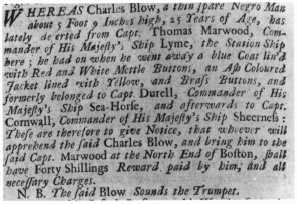
Fig. 267. Notice from the Boston Gazette, April 14, 1729.
Capt. Thomas Durrell was commander of at least two royal ships adorned with trumpeters and stationed in the Boston harbor between 1724 and 1736. In 1729 a black trumpeter who had formerly served Durrell fled from his commander, Capt. Thomas Marwood. An advertisement appeared in the Boston Gazette for April 7, 1729 (fig. 267). The reward offered for his return indicates that Blow was in bondage or servitude, although it is not known whether the ship captains or the British Navy owned him.92 The advertisement, however, is of particular interest because it provides a resume of Blow’s service as a trumpeter, and because it reveals that black musicians as well as dancing masters were sometimes itinerant.
In 1736 another trumpeter serving Durrell seems to have met an unhappy end. The Boston Evening-Post for July 19, 1736, relayed the following tragedy:
Wednesday last His Majesty’s Ship Scarborough, Capt. Durell Commander, fell down to Nantasket, and the next Day sail’d with a fair Wind for Great Britain. While the Ship lay below, a Negro Man belonging to Capt. Durell, a. well known Trumpetter, called Cafar, having been with others in a Boat to the Light-house, in their Return, one of the Oars happened to fall over board, which Cafar endeavoured to recover, by jumping in after it, but was entangled in the Eel Grass and drowned.
In the short period between 1708 and 1720 Boston’s black population increased from 400 to 2,000 or one-sixth of the total population. Most colonial cities were experiencing a sharp rise in the number of crimes and New York and Charleston were living under constant threat of black uprisings. Amongst the tensions between blacks and whites appeared a diverting anecdote from the New-England Courant for December 18, 1721:
On Thursday last was solemnized here the Wedding of Two Africans, with an unaccustom’d Magnificence: One of the Negroes is said to belong to a certain famous LAWYER of this town. They went to Church in a Sley; where an Englishman stood as a Father to give the Woman in Marriage. After the Ceremony was over, an handsome Dinner was provided by the said Lawyer for the Entertainment of several Persons of Distinction, who were present, particularly ONE of great Note. The next Morning a Trumpeter came to give Joy to the new married Couple; and having sounded a considerable Time, the Bridegroom walk’d out in his Gown and Slippers, and rewarded him for his Service.
Quare, Whether the sagacious Gentleman of the Law, by making so publick a Wedding for his Negro, intended to put the Magistracy in Mind of their Duty, and provoke them to enquire into the Cause of his cohabiting with a certain French Lady as his Wife, tho’ they were never publickly known to be marry’d; Or whether he designed by it to ridicule and bid Defiance to the Government?
Yours, &c.
Although blacks were frequently the players behind the trumpet, white players were hired by town officials or the well-to-do to provide music for celebrations, ceremonies, and other civic occasions. Sometimes trumpeters were sent to play at the homes of important visitors or townsfolk. This use of the trumpet and other instruments was analogous to the medieval and Renaissance tradition of town waits or musicians in the employ of civil or military personages who provided music for celebrations, ceremonies, announcements, and salutations.
Samuel Sewall reports 5 such instances. Jacob Amsden, a glazier from Cambridge, played trumpet on at least one occasion. Sewall hired Amsden and three others to play trumpet at daybreak on January 1, 1701, to welcome in the new century. Perhaps it was also Amsden who awoke Sewall exactly four years earlier, on January 1, 1697, to wish him a happy and healthy new year. Amsden died in 1701, and “Col. Hobbey’s Negro” played for Sewall on January 1, 1705. On January 2, 1710, Sewall wrote in his diary: “Môrat Salutes me with the Sound of the Trumpet. Govr warns a Council. . . .”93
Môrat, or Murat, a coachman as well as trumpeter, appears in Sewall’s diary three times, but in no entry does Sewall use his given name. On July 22, 1712, Sewall cites the following: “Dr. C. Mather, Sir Charles Hobby, Major [Thomas] Fitch and I set out for Natick. At Mills’s the President meets us, Fisher conducts us, Mr. Deming in company, Banj. Larnell waited on us. Murat was there with his Trumpet.” A clue to Murat’s identity lies in an entry for January 27, 1719, where Sewall states: “Upon Mrs. Belcher’s kind Invitation yesterday, I rid with Mr. Paul Dudley, in his slay to the Ferry, Murat driving us.”94 From this entry, it would seem that Murat was in the employ of Paul Dudley the governor’s son. It is not known whether Murat was black, white, in bondage, servitude, or a free man. Earlier he might have been in the service of Maj. Fitch whose name appeared in the first two entries, or Sir Charles Hobby who was fond of the pomp Murat could provide.
Until 1739 drums were used primarily for public and martial purposes; they were beaten to announce news, to call up volunteers, to publish laws and proclamations, to direct militia on training days, and to bring the congregation to the meetinghouse on lecture day and the Sabbath when there was no bell. They rattled warnings against Indians, fire, and attacks, and at sea they served as a warning to other boats during heavy fog. (See Appendix B.)
Instruments necessary to the welfare of the colony were made by its inhabitants. It will be recalled that two probable fifemakers were identified: Arthur Clarke (d. 1665) (see fig. 261), and John Dyer (d. 1696). Another early instrument maker was Robert Crosman (d. 1692), a “mechanic” and “drum-maker” who lived first in Dedham, then Dorchester, Massachusetts, before removing to Taunton.95 A drum by his son Robert, labeled “Robert Crosman, of Taunton/New England Anno dom 1739,” still exists in the Old Colony Historical Society in Taunton (fig. 268). As the military use of drums is out of the scope of this paper, research on this interesting family of drum makers is still in order.
The few instances when drums were used with other instruments already have been mentioned. In brief, they are: Francis Willoughby’s interment in 1671; in remembrance of the king’s birthday on October 14, 1686; the entrances of the royal governors Sir Edmund Andros and Richard Coote, Earl of Bellomont; and the proclamation of the Peace of Ryswick in 1697 when “Eight or 10 Drums and Two Trumpets” were sounded. The year 1739 saw a grand procession of the Society of Free Masons which was headed by “A Compleat band of Musick, consisting of Trumpets, Kettle Drums, &c. . . .” This confirmed a new musical era for Boston.96
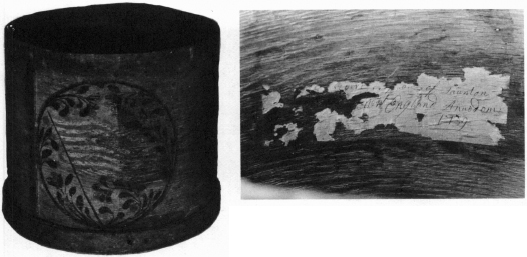
Fig. 268. Side drum and its label by Robert Crossman, Taunton, Massachusetts, 1739.
governor william burnet (1688–1729)
William Burnet (fig. 269), Governor of the Massachusetts Bay Colony (1728–1729), owned more instruments than any other New England resident of his time, according to extant records. An aristocrat, an Anglican, a Crown-appointed governor, Burnet heralds the development of a wealthy, leisured, luxury-loving aristocracy in the Massachusetts Bay Colony and signals the demise of Puritanism at the upper levels of society.
Undoubtedly Burnet had acquired his affection for music in the atmosphere of his parents’ home. His father, Gilbert Burnet, the much-respected Bishop of Salisbury, was a man of superior understanding and a member of the political and cultural elite. William Burnet was born in The Hague during his father’s temporary residence there and had the good fortune to be the godson of William III (after whom he was named) and Queen Mary. In 1720, upon his appointment as governor of New York and New Jersey, Burnet set sail for the New World with a retinue consisting of his household staff and his friend Stephen Deblois. (Stephen Deblois and his sons were to become signally important to the musical life of Boston in the eighteenth century, and it is suspected that they presented the earliest public concert. The advertisement for it is reproduced in fig. 237.) In 1728 Burnet was transferred to Massachusetts by George II, and he entered the city with more pomp and circumstance than ever had been displayed in Boston.97
Fig. 269. Portrait of Governor William Burnet (1688–1729) of New York then Boston, attributed to Gerardus Duyckinck, New York, 1720–1728.
Musical instruments, to be sure, were the apparatus of culture; they were the means by which a man of political status such as Governor William Burnet could provide ceremonial music and entertainment for his guests. In eighteenth-century Europe, many politically prominent figures and aristocrats, as well as officers of the regiments, retained their own bands of music.
Governor Burnet’s household staff included “Andrew a Negro Man a Trumpeter” (see fig. 372 in Cynthia Adams Hoover’s contribution to this volume), but no other purely musical staff member was identified in his inventory. It is not known whether Burnet himself or members of his family played on his array of instruments or whether others of his staff doubled as instrumentalists. In addition to “Two Brass Trumpets £04.–.–” which Andrew no doubt played, the 1729 inventory reads as follows (fig. 270):
|
A large bass Violine 5li Two Trible Violins |
|
|
30/7 |
8. |
|
A Harpsicord |
60. |
|
A Clepsicord |
15. |
|
A double Courtell |
2. |
|
A large Violin or Tenor fidle |
2. |
|
. . . |
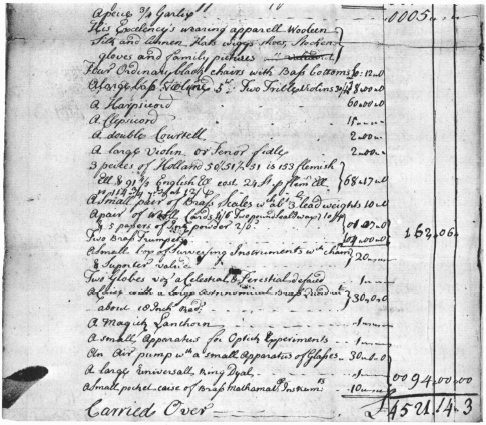
Fig. 270. Detail from page 10 of the household inventory of Governor William Burnet, Boston, 1729. (For another detail, see fig. 372.)
The true bass of the violin family, the violoncello, was known as the bass violin or violone until at least 1700. It is impossible to know whether the “large bass Violine” Burnet owned was the larger or smaller size of the violoncello (fig. 271). Although both sizes were tuned in the same way, the difference of about ten centimeters was great enough to permit a more sonorous sounding lowest string on the larger size. The drawback to the larger size was in the difficult stretches of the hand required by certain musical compositions. The invention of wire-wound strings about 1660 made it possible to produce the quality of sound of the larger size on the smaller version.98 The large size, however, remained in use in the colonies, particularly in the churches, well into the nineteenth century. The two violoncellos shown in figure 271 were made by Benjamin Crehore of Dorchester, shortly after of Milton, Massachusetts, thought to be one of America’s earliest luthiers. They illustrate that the two sizes of violoncellos were still being made at the end of the eighteenth century.
Fig. 271 a. and b. Bass viol (large-sized violoncello) and its label by Benjamin Crehore, Dorchester, Massachusetts, 1788.
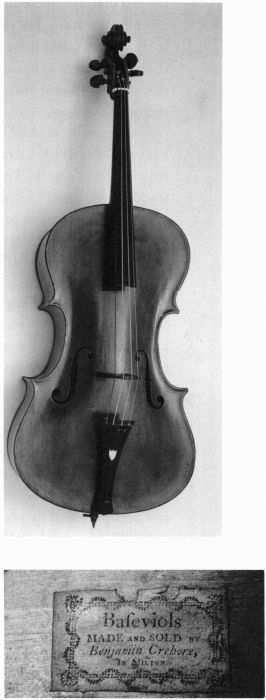
Fig. 271 c. and d. Violoncello (standard-sized) and its label by Benjamin Crehore, Milton, Massachusetts, ca. 1795.
Sometimes the bass violin, as well as the bass viol, had two holes in its back through which a strap could be threaded and the instrument hung from a player’s neck. The latter arrangement permitted the player to stand or walk and play at the same time, a handy feature for instrumentalists marching in processions. Perhaps there were similar holes in the viols which were played in the procession on Thursday, October 14, 1686, on the occasion of the king’s birthday. Samuel Sewall described it: “Many Guns fired, and at night a Bonfire on Noddles Hand [sic], in remembrance of the King’s Birth-day; ’tis the more remarkable because Wednesday Octr 13th was the day the Generall Court was adjourn’d to at 8 aclock. Upon Thorsday [sic] before Lecture the Guns fired; some marched throw the Streets with Viols and Drums, playing and beating by turns.”99
Burnet’s “large Violin or Tenor fidle” (fig. 272) was approximately five to seven centimeters larger than the viola; tuned, like a viola, a fifth below the violin; and held either under the chin or on the lap. It was a common instrument during the seventeenth century, but fell into obscurity (as did the violone) during the eighteenth century when the smaller size was preferred by players for ease in handling. Examples, though, were still being made in New England into the nineteenth century.
Essentially, then, Burnet would have owned a quartet of strings: two violins, a large size viola or tenor violin, and a bass voice, an oversized violoncello or violone.
One cannot but wonder if perhaps Andrew, Burnet’s “trumpeter,” might have been adept on other instruments as well. Playing the trumpet would have been his public face. He would have performed primarily on ceremonial and civic occasions, like the trumpeters Amsden and Murat mentioned in Sewall’s Diary. Andrew might also have doubled on violin, one of the most useful domestic instruments, whether it be for dancing, or for playing popular or serious music. If he played violin, the other stringed instruments would not have been difficult for him. The curtal (fig. 273) was a practical instrument to play, too. It was the bass member of the typical outdoor wind band of instruments which consisted of two horns, two or four oboes (depending on whether or not two clarinets were included in the ensemble), and two curtals or bassoons (see vol. I of this book, fig. 73). Indoors it could have been used as an alternative continuo instrument to reinforce the bass line of compositions with harpsichord accompaniment.
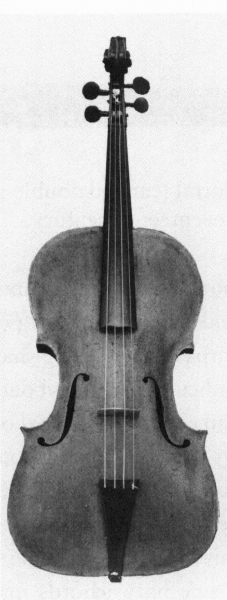
Fig. 272a. Tenor violin by an unknown maker, United States, late eighteenth or early nineteenth century.
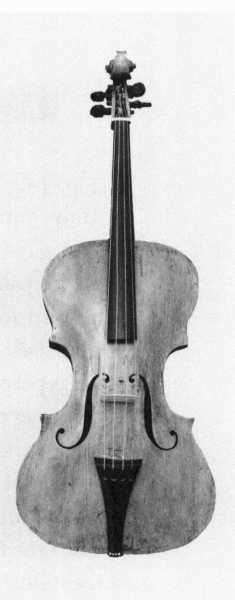
Fig. 272b. Tenor violin by an unknown maker, United States, ca. 1800–1820.
Fig. 273. Curtal (capped double-reed ancestor of the bassoon), Italy, mid-seventeenth century.
A harpsichord valued at the unusually large sum of sixty pounds100 was also found among Burnet’s possessions. This was undoubtedly a full-fledged harpsichord; a wing-shaped, plucked-action instrument with strings perpendicular to the keyboard (fig. 274). The harpsichord proper was larger than either the virginal or spinet; it could accommodate two or more choirs of strings and had one or possibly two keyboards, with a compass of about four and one-half octaves.
Since Burnet had spent his earliest years in The Hague, and had attended the University at Leiden, he was quite possibly familiar with the exceptionally fine harpsichords made by the Ruckers family (1589–1667) of Antwerp. These instruments became so fashionable during the eighteenth century that other harpsichord builders would incorporate pieces of old Ruckers harpsichords into their own instruments and sell them under the “Ruckers” name at an inflated price. Given the value of Burnet’s harpsichord it would not be surprising to find that he had a double-manual Ruckers harpsichord which he could have acquired in Holland.
A “clepsicord” was also listed in Burnet’s inventory. This is a unique term; it appears in no other source known to this writer. It could be a misspelling of the word clavichord, a little-seen instrument at the time Burnet’s inventory was taken and probably unfamiliar to the appraisers, who appear to have had some difficulty identifying the instruments.101
Fig. 274. Harpsichord by Thomas Hancock, London, 1720.
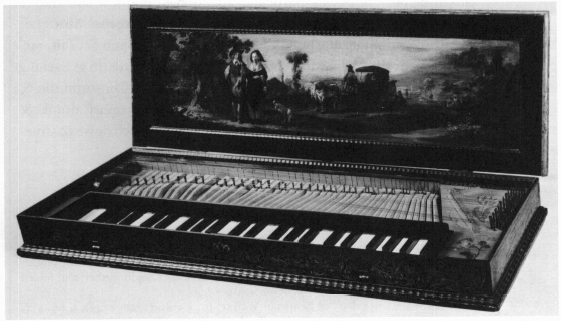
Fig. 275. Clavichord by an unknown maker, Flanders, seventeenth century, with a lid painting by Dirck Stoop, Flanders (1610–1686).
A clavichord (fig. 275) was a small keyboard instrument with upward striking tangents (thin metal blades perpendicularly inserted into the end of the key lever). It was perhaps the most intimate of instruments because of its soft voice, yet within its limited volume of sound it offered a wide range of dynamic possibilities. It had been a common instrument of the sixteenth century, but fell out of fashion in England during the early eighteenth century, when English taste began to turn to opera and the larger-scale instrumental works of Handel. Certainly a clavichord may have been found in the possession of conservative music lovers, who were still practicing seventeenth-century consort music, but for someone with the more fashionable ensemble of a quartet of bowed stringed instruments from the violin family, the possession of a clavichord seems less feasible.102
In short, the combination of musical instruments owned by Governor Burnet at the time of his death in 1729 would have made a large repertory of music available to its players.
Little is known about how Burnet’s array of instruments were actually used. A journal containing mostly an elaborate record of weather conditions written by a fellow Anglican and Boston shopkeeper, Benjamin Walker, Jr., affords one of the few glimpses of Burnet’s musical life in Boston. In it Walker offers his personal observations of public life as a citizen of Boston, paying particular attention to political and church figures. His entry for Monday, November 4, 1728, records “Morn fair sml wind: Sat noon sunshin’d dull Sml wind ssw at Sun Set fair sml wind s. a fair still night. Mṛ Henry Home at Jona Barnards In ye Evening Made an Entertainment 20 or 30 Gentlerh Heard a Consortmusic & Trumpet ye mon in street In: Wṃ to Immortul memory drunk & Hurra’d In ye bellcony & In Street before ye door much noise & Company I was after there my brothr [illegible].”103
Exactly who the players of Burnet’s instruments were is not known other than Andrew the trumpeter. Earlier, mention was made that Stephen Deblois was among Burnet’s retinue while he was in North America, and that the first public concert in North America was given in Boston on February 18, 1729. Burnet was still in office (he did not die until September 7 of the same year), and the will of another instrument owner, Increase Gatchell, had been probated only six days before this first concert. Although there were numerous musical instruments in Boston at this time, and Pelham and Grainger were giving music and dance instructions, it is tempting to wonder whether Burnet’s instruments and Stephen Deblois participated in this seminal concert.
Governor Burnet’s instruments did not remain in the family. Just after his death an advertisement appeared in the Boston Gazette for October 6, 1729 (see fig. 270), to give notice of the impending auction of the Governor’s effects including his musical instruments.
conclusion
A wide selection of instruments was owned by the residents of the Massachusetts Bay Colony. Found among their possessions were harpsichords, an organ, a possible clavichord, lutes, guitars, citterns, a dulcimer, viols, violins, flutes, fifes, a mock trumpet, a curtal, trumpets, and drums. Although the number of recorded instrument owners compared to the population was small, the evidence presented in this study illustrates that secular social music permeated every corner of society. They included urban and rural colonists; men, women, and children; blacks and whites; all social classes: the middle and upper, the humble and ordinary, Puritan and non-Puritan.
All types of social music were played by the colonists: popular, traditional, and serious. Although few direct references to the practice of serious music are extant—except, perhaps, for the mention of music books in the public documents of the Rev. Edmund Browne (1606–1678) and Joseph Curtis (d. 1700)—musical ensembles were suggested by the social relationships obtaining among instrument owners and by the instrument groupings found in individual inventories. Because Massachusetts Bay was in fact a cultural outpost of England, serious English musical compositions have been suggested by the writer as likely music played by the colonists.
Why, then, with the variety of instruments available to the colonists and the practice of all forms of secular social music so widespread, was the number of recorded instruments so small? While an assumed answer to this question seems forever lost, there are some obvious hypotheses based on the evidence at hand.
Most of the instruments recorded were of substantial value and serious musical potential. These instruments of course would have been preserved, not only for their monetary worth, but for sentimental reasons, or as decorative objects. On the other hand, there is a distinct absence of less expensive instruments such as the many varieties of flutes, whistles, horns; and among individual owners, single jew’s harps. This absence can be explained by two suppositions. First, instruments were handed on to the next generation before the owner died, especially the small, less valuable ones, because people were more likely to play instruments in their early and middle years and abandon them later. And second, the assessors may have purposefully omitted them from the inventories because they were neither of monetary worth nor of practical use.
More instruments were recorded in the earlier years of the century under examination than in the later years. Several explanations are possible. First, earlier records were more accurate: as the colonists became more established, and the society more wealthy, fewer individual items were recorded. Second, church music and the method of singing it were simplified in order to emphasize the sense of the text and deemphasize its aesthetic and virtuosic qualities. This may also have affected the frequency and number of individuals playing secular social music.
The Puritans dominated the first three generations of the colony. One of their chief concerns was that in the singing of psalms neither the music itself nor the act of reading music should interefere with one’s concentration upon understanding the text of the psalms. Therefore, a new translation of the psalms, the Bay Psalm Book (1640), was undertaken as the first colonial printing endeavor. The texts of the elegant version by Sternhold and Hopkins were clarified and their metre simplified for singing. In The Singing of Psalmes a Gospel Ordinance which John Cotton sent to London for publication in 1647 he reiterated: “those who want either books or skill to reade, may know what is to be sung, and joyne with the rest in the dutie of singing.”104 Thereafter the practice of lining out was adopted. A precentor sang the psalm, one line at a time, with the congregation repeating it. In this way everyone could accomplish his or her duty whether or not he or she could read music. Lining out, then, relieved the pressure; no longer was it required that a Puritan be able to read music; consequently the impetus and the ability to read music waned among the believers. This deemphasis of music in the church may also have had a direct effect upon the practice of playing serious secular music. The third explanation is simply that there is not enough evidence at hand to make any conclusive statements concerning the decline of documented instruments in the first decade of the eighteenth century.
Climate, too, had a decided effect on the number of instruments which survived long enough to be recorded at the death of the owner. The instruments which survived are harpsichords, citterns, guitars, lutes, viols, and violins—instruments of delicate construction and fragile constitution. They were probably made in England and brought to this country by the emigrants, or perhaps imported for sale. England has the advantage of a less severe and more constantly humid environment, in short, one more favorable to the preservation of musical instruments. It is a wonder that any instruments built in the one climate and brought to the other could have survived at all.
Among colonial instrument owners the range of occupations and distribution of wealth was wide, and the owners were concentrated in the urban areas. The slight representation of farmers is surprising since over ninety percent of the population was agrarian. Several conjectures suggest themselves. A number of farmers, especially those close to the urban centers, had a second occupation by which they were distinguished; this would tend to obscure their yeomanry. Also, the distances between truly rural inhabitants and assessors were sometimes great. This, combined with the often low value of their estates, which could easily be divided among inheritors without dispute, may have discouraged the assessors from taking the time and trouble to travel long distances to record meager possessions, among which were probably inexpensive instruments. One reason for the concentration of instrument owners in urban areas is that they were generally wealthier, which allowed the acquisition of instruments and leisure in which to play. Another is that players were closer to one another and had more opportunity for playing together.
Earlier it was also stated that 38 owners of musical instruments were probably first generation, 37 were second or later generation, while the generations of 44 are unknown. While it appears to be a one-to-one ratio of generations, which would suggest the continuance of their musical tradition as a cultural colony of England, the category of unknown origins is so large as to make this evidence inconclusive.
How did the colonists acquire their instruments? Obviously many considered them essential enough to include them among the limited possessions they brought to the New World. Others upon their arrival may have sent back to friends or relatives for them. Leonard Hoar’s letter from London in 1661 is one example (see this study pp. 478 and 479).
From the evidence in several inventories and one town’s records it is also suspected that there were at least three instrument builders working in the colony. They were Robert Crosman (d. 1692), who in 1640 was identified as a “drum-maker”; Arthur Clarke (d. 1665), a woodworker and a fife maker; and John Dyer (d. 1696), an ironmonger and possibly pewter fife maker. The instruments they made had very practical uses in the defense of the colony. Since citterns were the most commonly found instruments among the colonists, it was not surprising to find someone making wire for them. The ironmonger Robert Cutler (d. 1665) who had “a pcell. of Citternwier . . . In the new Shop” may well have been making it himself.
Fig. 276. Advertisement from the Boston News-Letter, April 16, 1716.
The concentration of merchant-owners would suggest that some instruments were imported, too. After many attempts to locate seventeenth-century bills of lading to confirm this, the evidence at last was found in the Public Record Office in London. There, custom records certified that instruments were exported to New England at least by 1699. A cargo containing an unspecified number of “Musicall Instrumṭs” valued at fourteen pounds was entered under “Lond.—Exportacṇ of Eng. Manufactures from Xtmas. 1698 to Xtmas. 1699 With an Estimate of their first Cost or Value Vizṭ”105 Until the late seventeenth century, then, it would seem that musical instruments were either brought by the colonists, shipped to them on special order, or, in a few instances, made here.
On April 16, 1716, the Boston News-Letter carried an advertisement (fig. 276). It is important as a signal of the cultural and social transition beginning around 1720 when luxuries were imported on a large enough scale to permit retail specialization. As this advertisement illustrates, musical instruments were among the first of such specialties.106
The newspapers carried advertisements for others who specialized in the trafficking of instruments and their appurtenances. In 1724 Increase Gatchell offered for sale “Choice good Italian Fiddle-Strings.”107 The November 25, 1731, issue of the Boston News-Letter announced “London violins” for sale at Roger Hardcastle’s shop on the “North Side of the Town house.” Earlier in the same year the Boston Gazette for February 1, 1731, ran an advertisement for the return of a “Lads Fiddle or Violin” which had been stolen from Joshua Winslow’s warehouse, an indication that the musical desires of children as well as adults were being satisfied in Boston. And, as noted earlier, Samuel Grainger quite possibly carried on the “musical emporium” side of Enstone’s enterprises after the latter departed from Boston.
The dealers were disseminators of musical instruction as well as distributors of its tools (see Appendix C). As mentioned earlier, George Brownell in 1713 was the first dancing master to be permitted by the selectmen to practice his profession as a resident of Boston. Following on his heels in 1714 was Edward Enstone. Having accepted the bequest of Thomas Brattle’s organ, the Vestry of King’s Chapel procured Edward Enstone, an organist from England, to play it. In February of 1714 the vestry minutes recorded the following observations with regard to Enstone’s salary: “which [salary] with other Advantages as to Dancing, Musick etc., we doubt not will be sufficient Encouregement [sic].” By December of 1714 Enstone had “assumed the duties as organist.” Not only did he provide Boston with sacred instrumental music, but he offered the opportunity to dance and to learn to play musical instruments.108 The selectmen, however, disapproved of his “keeping a School as a Master of Musick & Danceing Mastr.” Complaints were filed on February 21; and October 25, 1715, and again on April 3, 1716.109 Despite this, only two weeks later the above advertisement (fig. 276) appeared.
Why would the selectmen disapprove Enstone? Perhaps because he was a man from the church and therefore setting a bad example, but more likely the reason was a practical one. Constantly troubled by wards of the city, the selectmen were concerned by the increasing number of inhabitants in Boston who were unable to find work.
The Boston News-Letter for February 23, 1713 advertised dancing lessons, instruction on various musical instruments and needlework taught by George Brownell. Yet in the same paper for August 20, 1716, he offered only needlework. Had he actually discontinued music and dancing lessons in his school, or was he simply trying to avoid public confrontation? Had he a disproportionate number of dancing and music pupils compared with those of needlework, or was he trying to avoid competition with Enstone for music students?
The frequent identity of dancing and music masters’ addresses during this period leads to the last conclusion. Brownell had preceded Enstone to Boston. On November 8, 1723, the church wardens and vestrymen of King’s Chapel voted “that Mr Edwḍ Enston deliver the key of the Organs to Messṛs Price and Gifford, that they may practise on the Organ in order to quallify one of them to be Organist, as shall be best approved of by ye said Church Wardens and Vestry.”110 Enstone shortly announced that as of December 10th his household goods would be for sale at his house on King Street.111 By December 23rd he continued dancing lessons at the house of Samuel Grainger, which had formerly belonged to the late Sir Charles Hobby “in the South End,” i.e., near the north corner of Bromfield Street.112 Shortly thereafter Increase Gatchell, who had been teaching dancing on Hanover Street, the very street on which George Brownell had offered dancing lessons from 1716 until his departure for New York in 1721, was selling fiddle strings in King Street.113
These examples suggest that there was a kind of professional conspiracy of helpfulness among the itinerant dancing and music masters which prevented them from inundating any one city with their art, and enabled them to reserve the larger, more commodious buildings in each for the practice of their discipline. Although the selectmen appear to have regulated academic schoolmasters and dancing masters through the issuance of licenses, it is strongly suspected that there was a self-regulatory system observed among the dancing masters themselves in order to protect and maintain the standards of their profession.
Carl Bridenbaugh in his Cities in the Wilderness stated, “urban culture though based largely upon wealth was also remarkably dependent upon the interchange and companionship of social living. Those arts and amusements especially flourished which could be indulged gregariously,—dancing and dining, music and the theater.”114 The itinerant music and dancing masters were finally socially accepted. They in large part helped to change the complexion of the country’s music. The widening of the channels of cultural exchange infused colonial culture with music, dancing, and its tools, musical instruments. Puritanism had lost its political dominance; wealth, leisure, and the importation of luxuries linked the New World to the Old; and an aristocracy was derived from the Anglicans, the royally appointed political figures, merchants, and to a lesser degree the established early families. The Puritan ethic, even at its height, was not the musicless desert envisioned by so many preceding scholars.

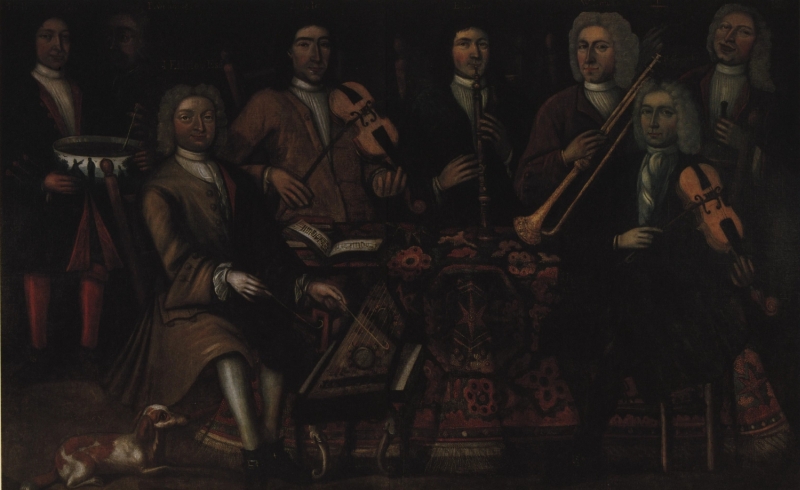
 BARBARA LAMBERT
BARBARA LAMBERT
